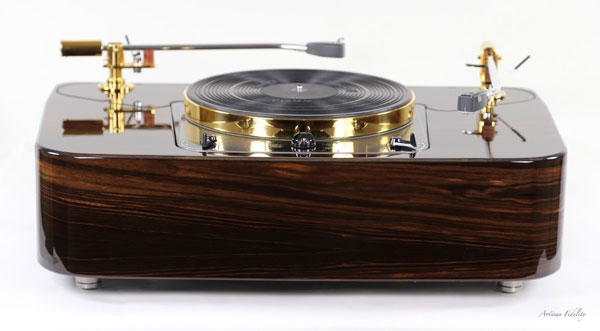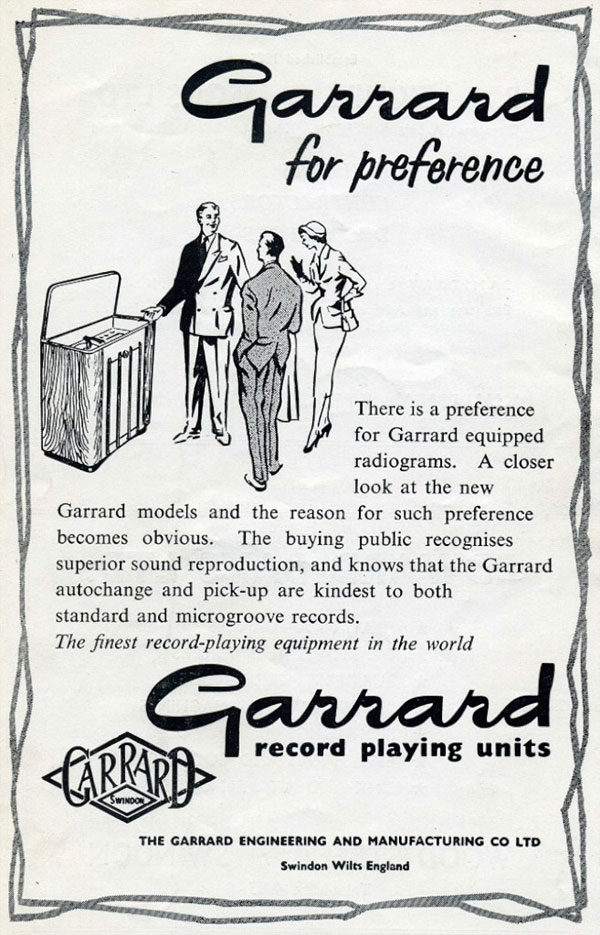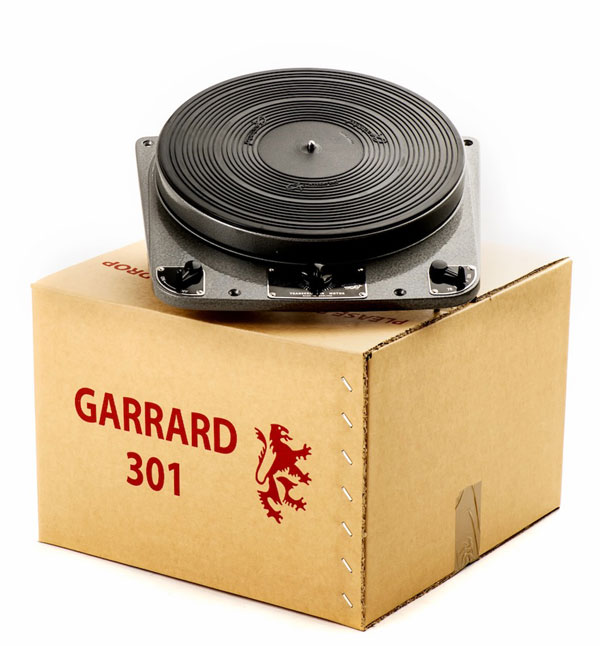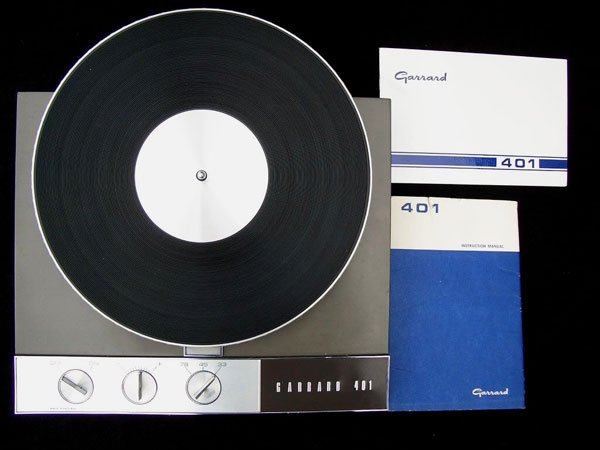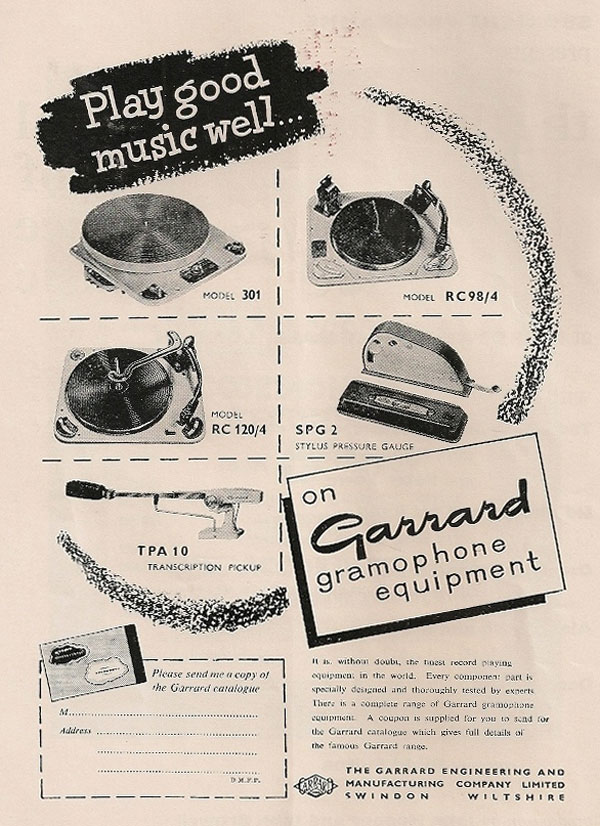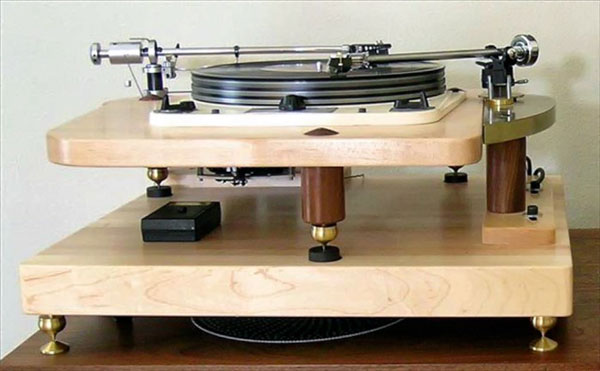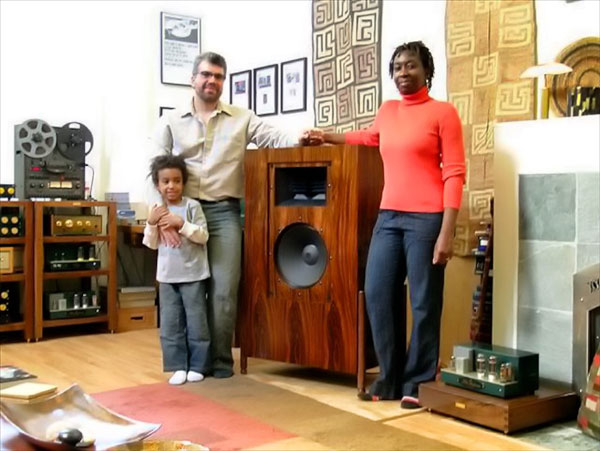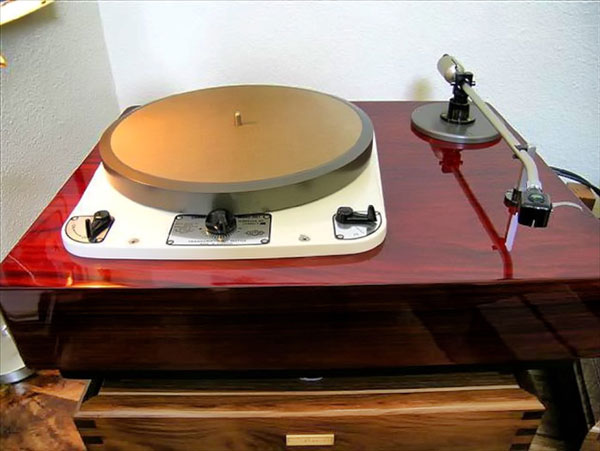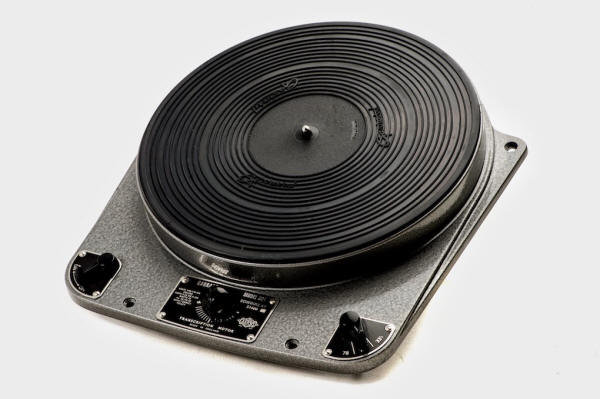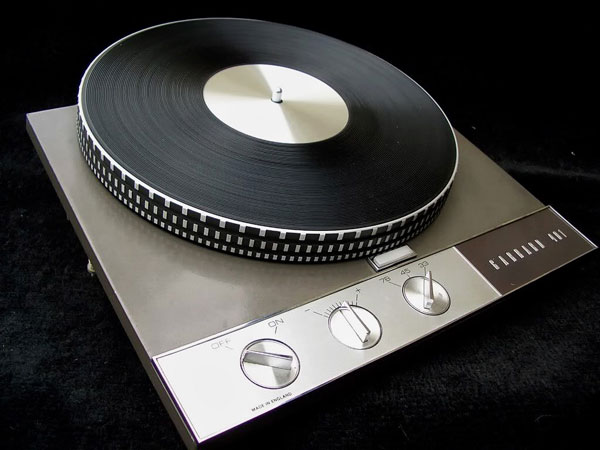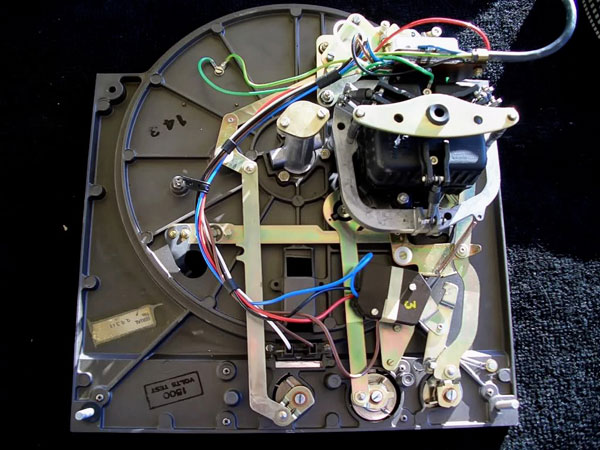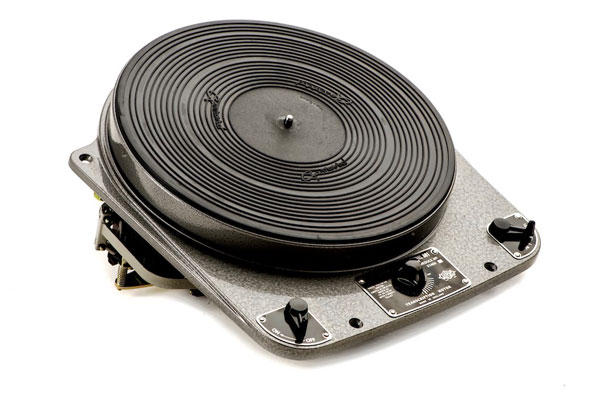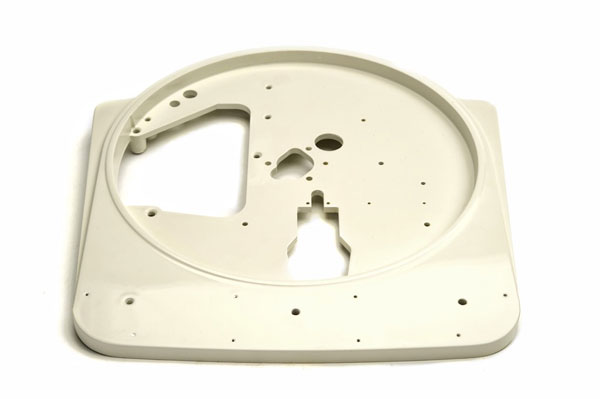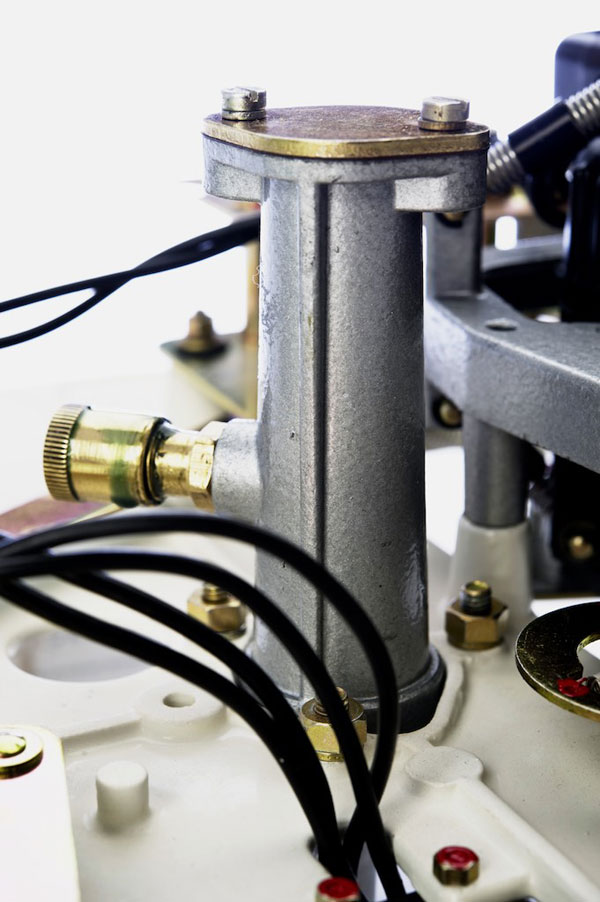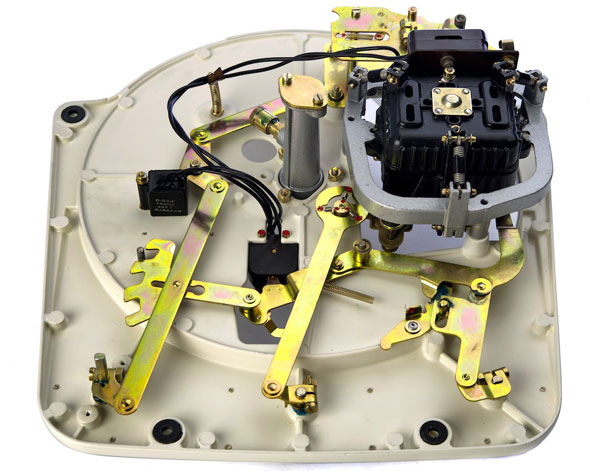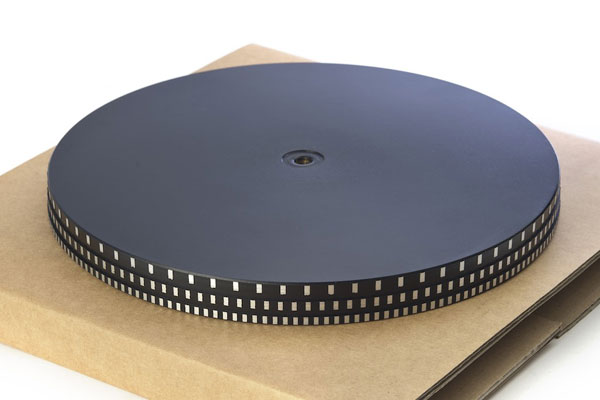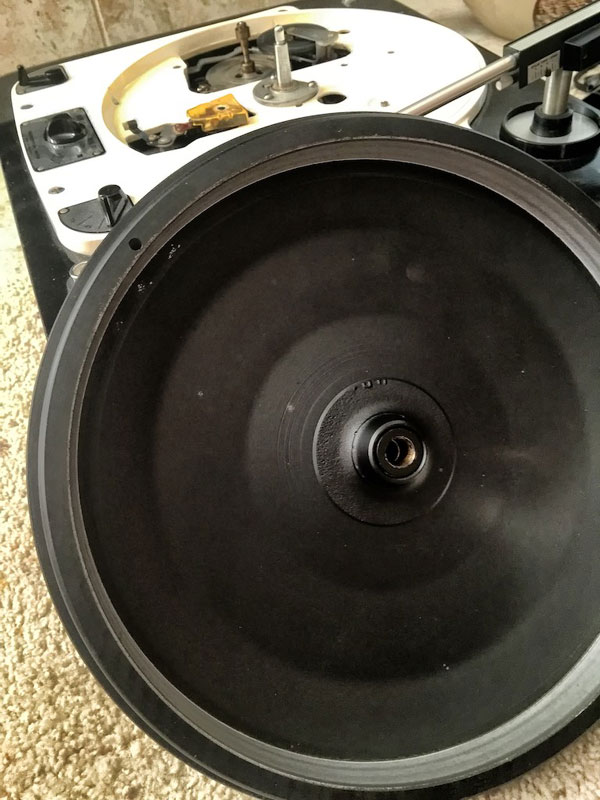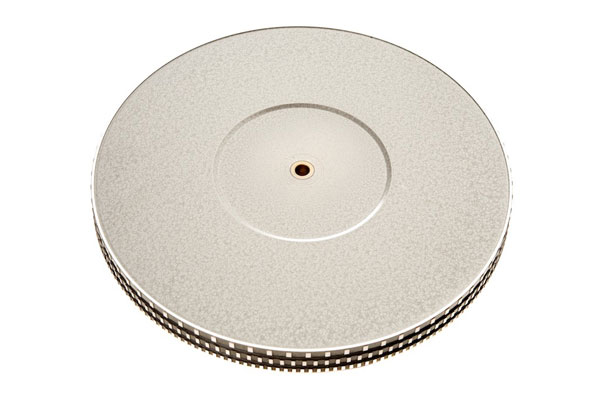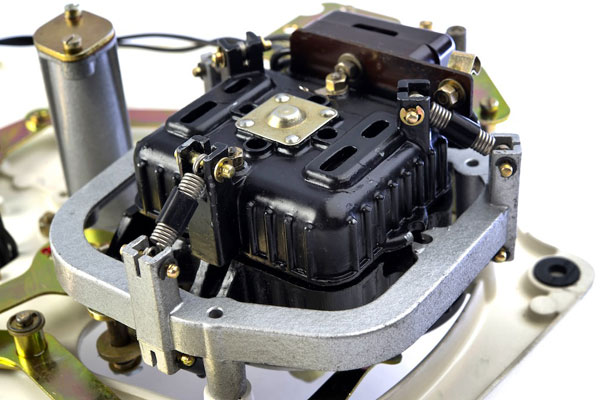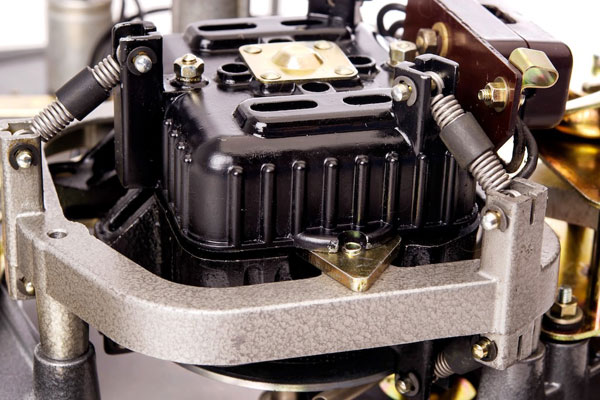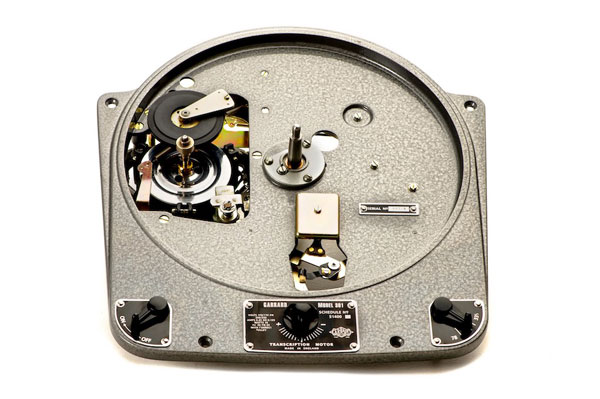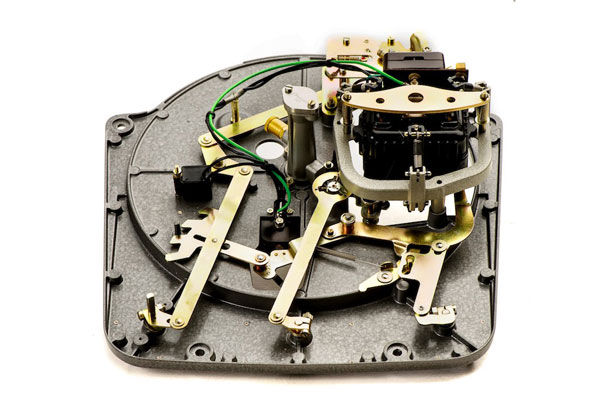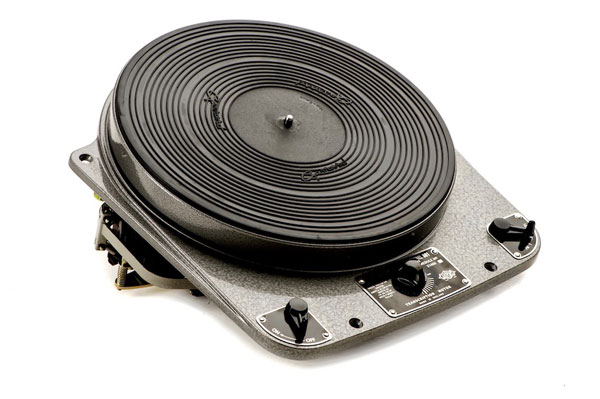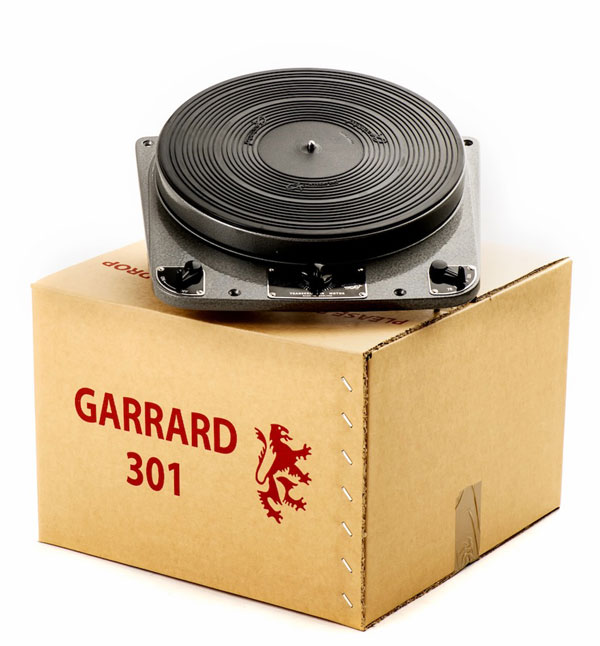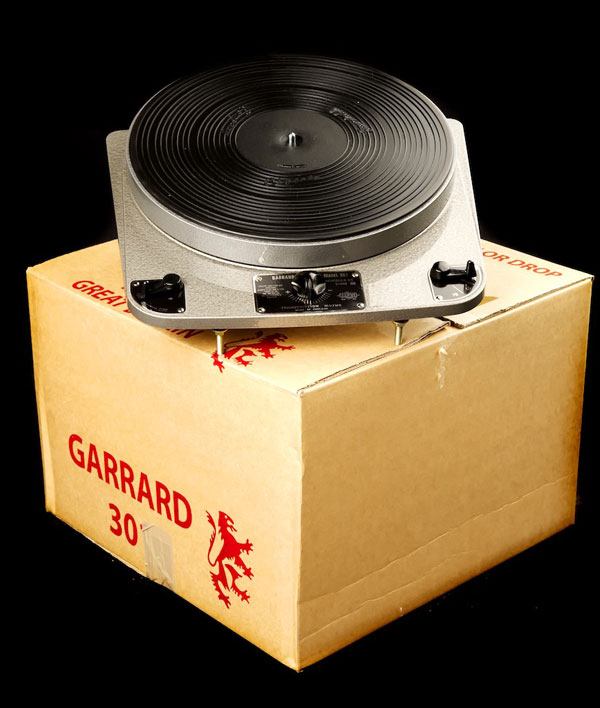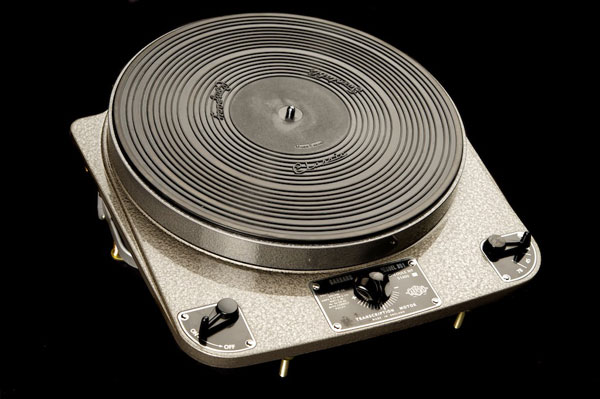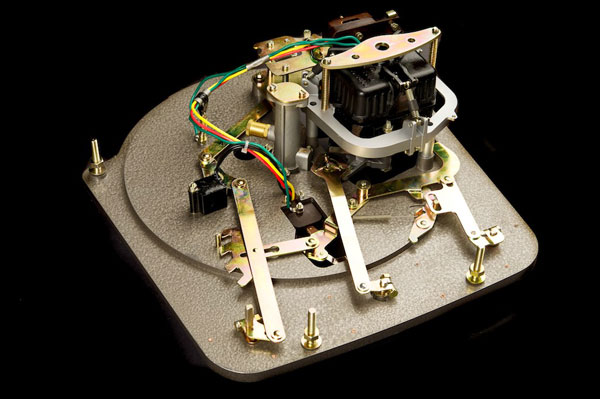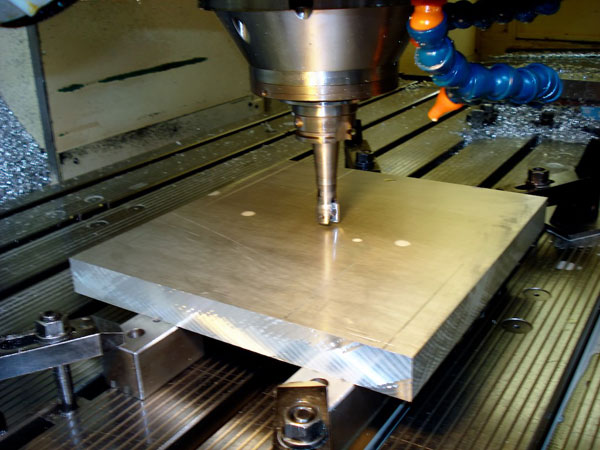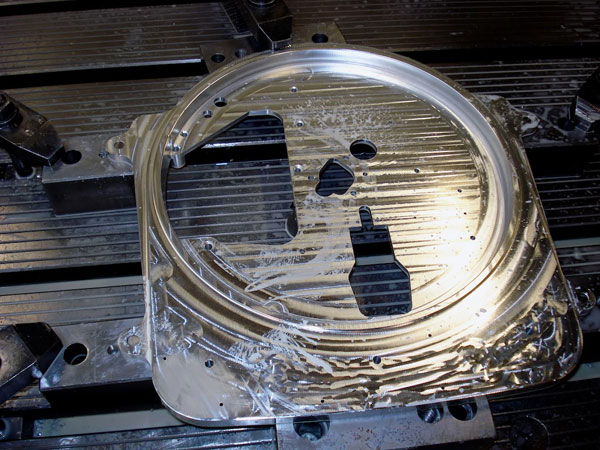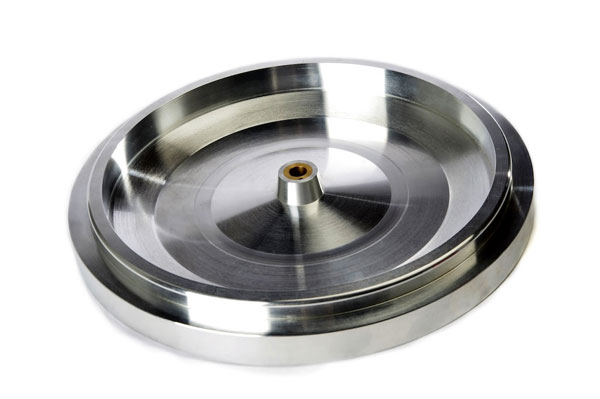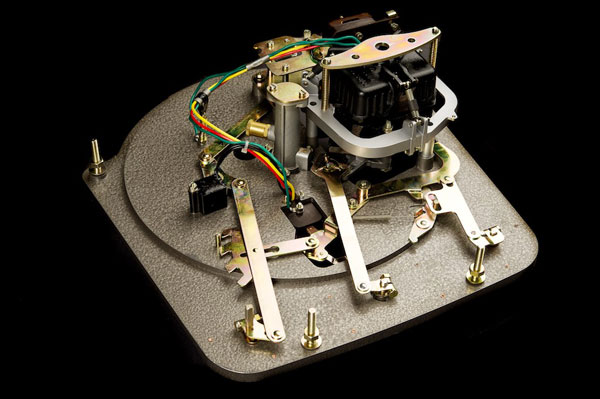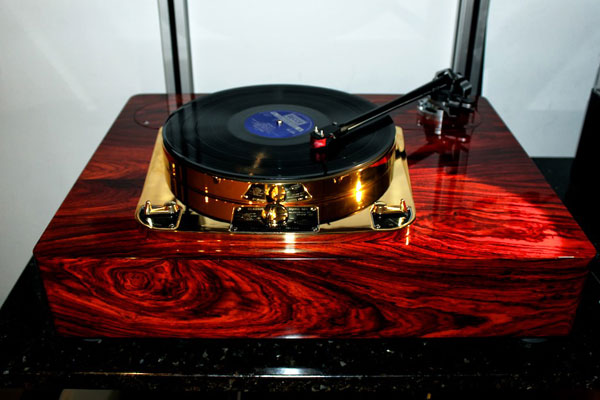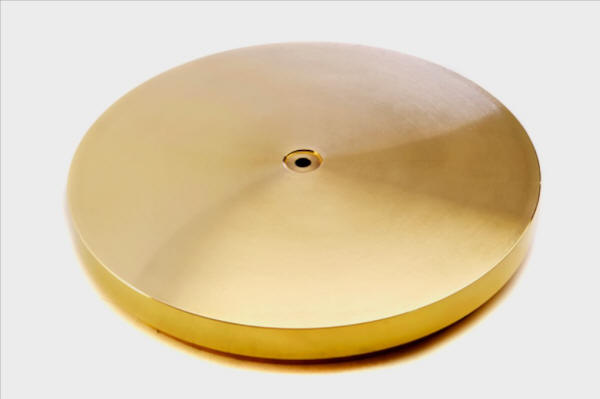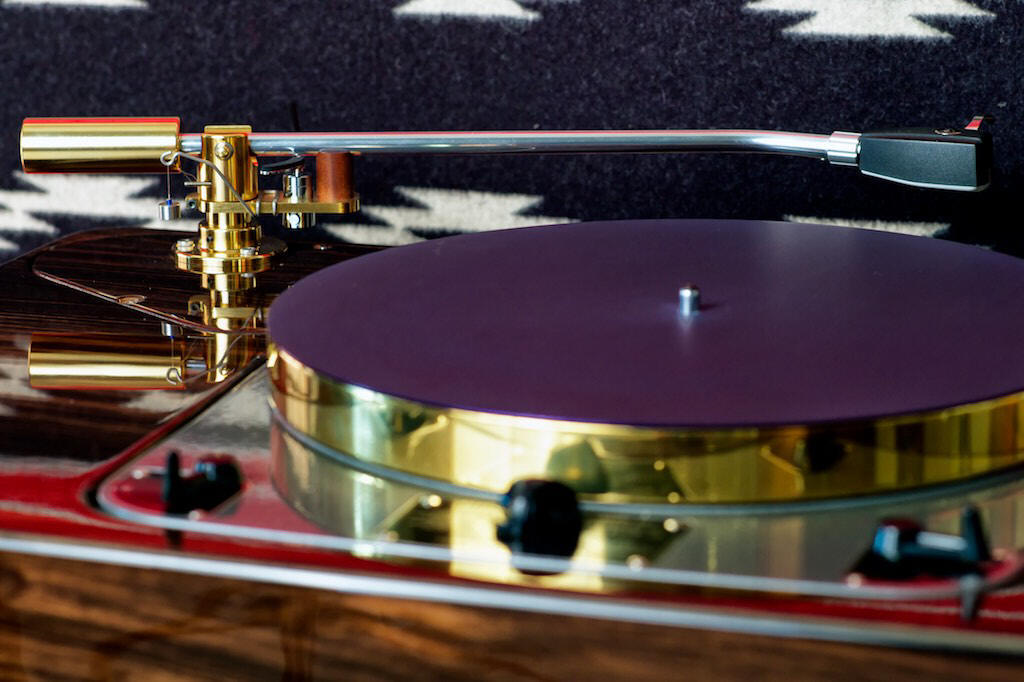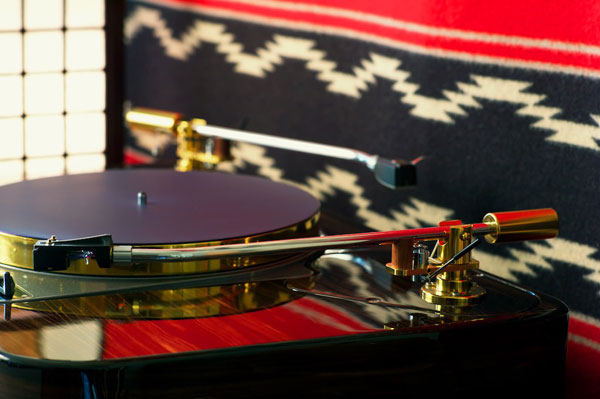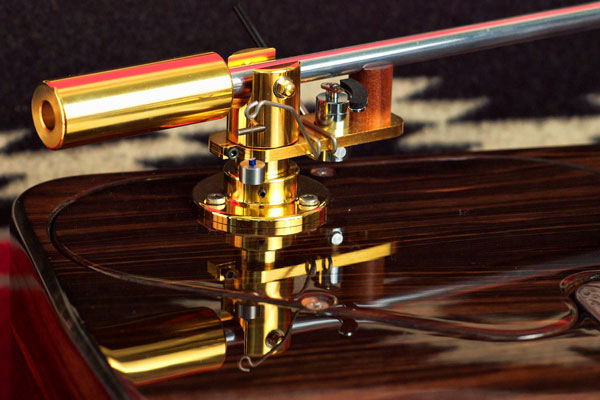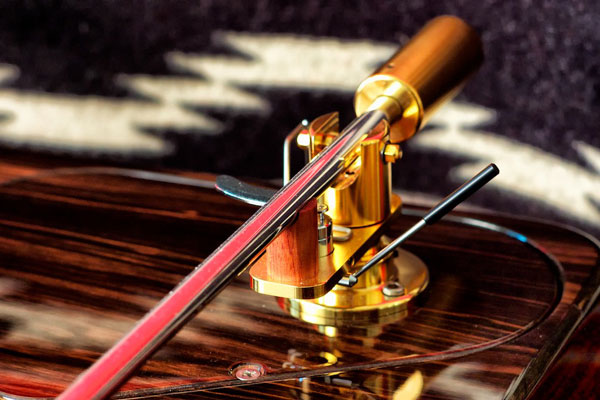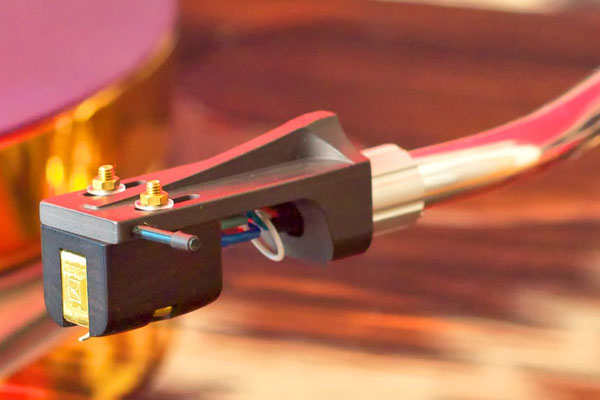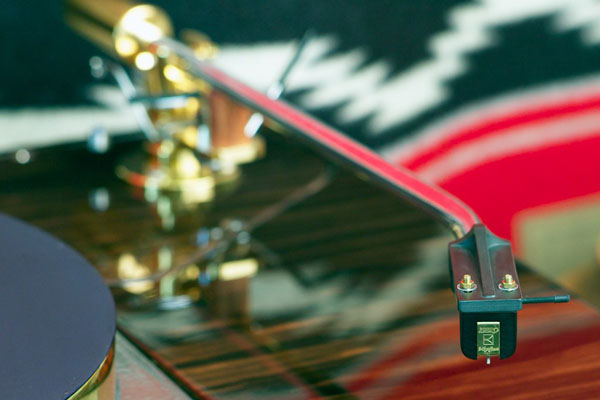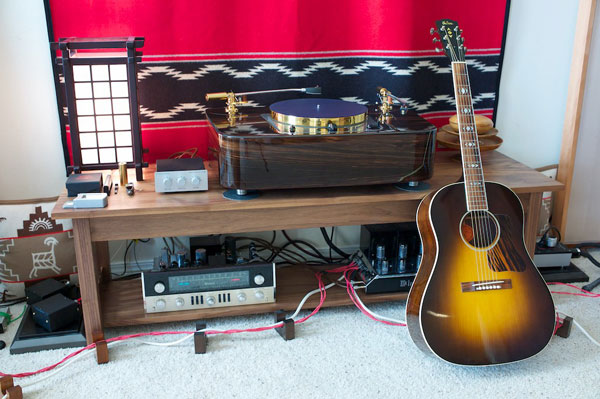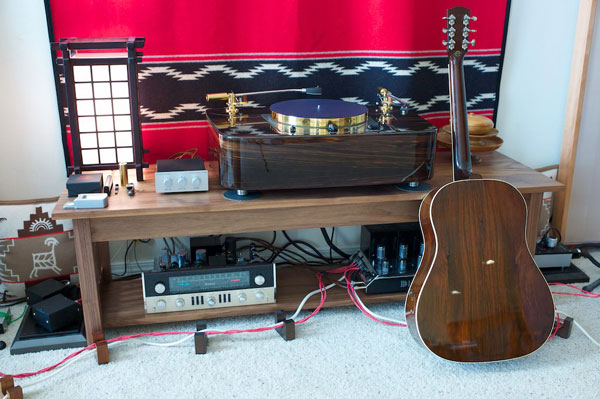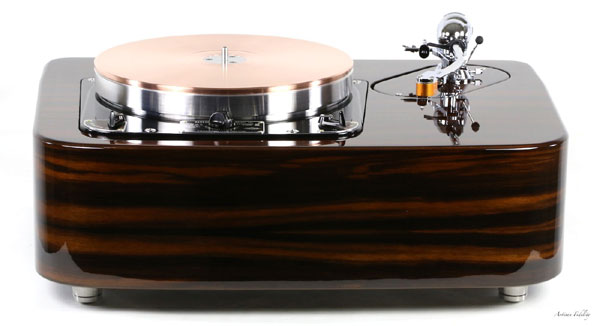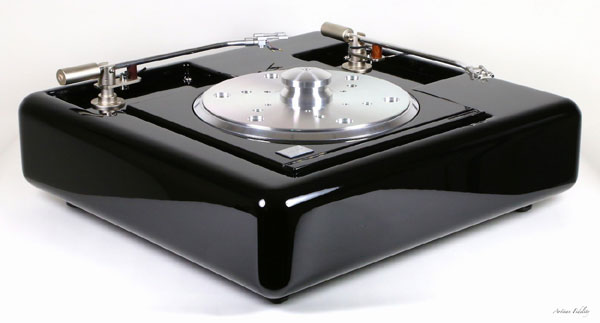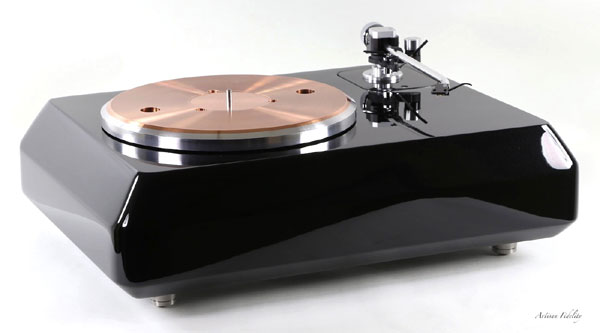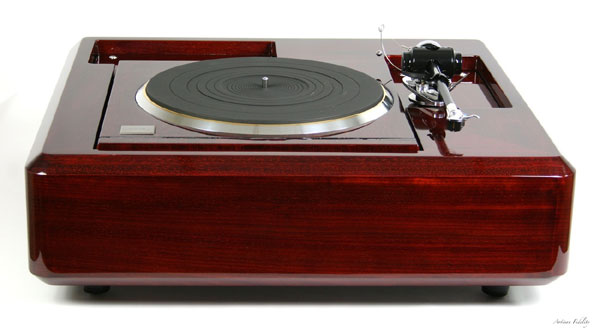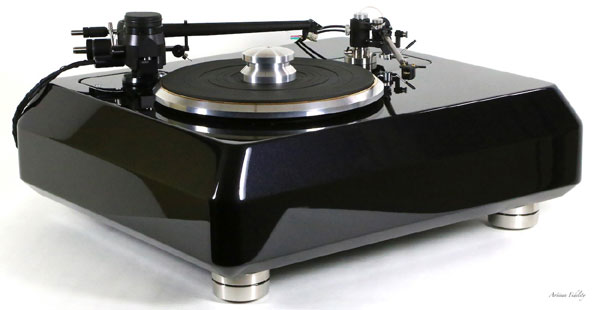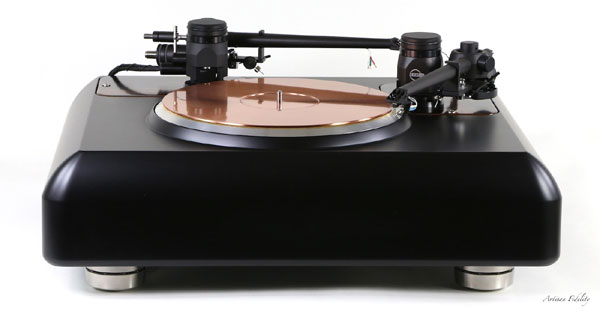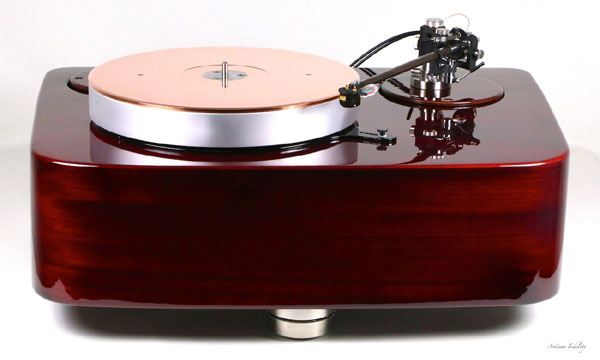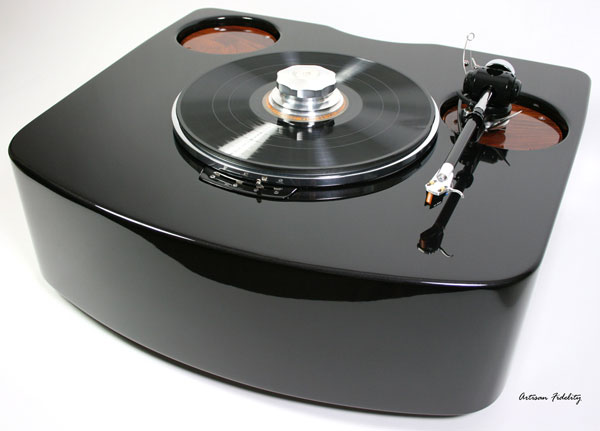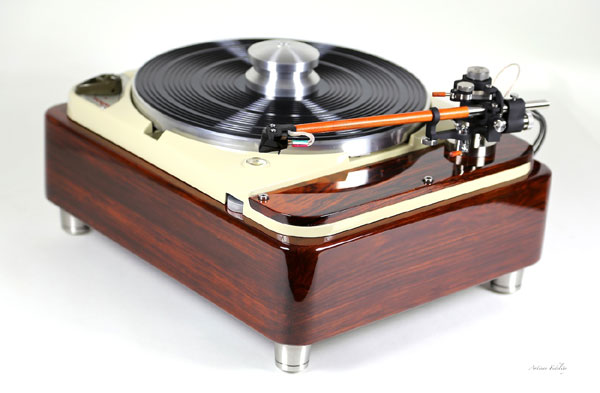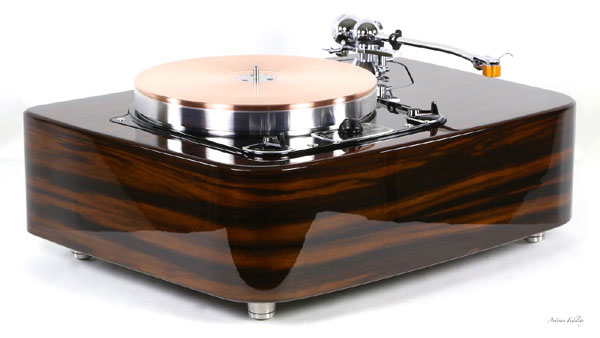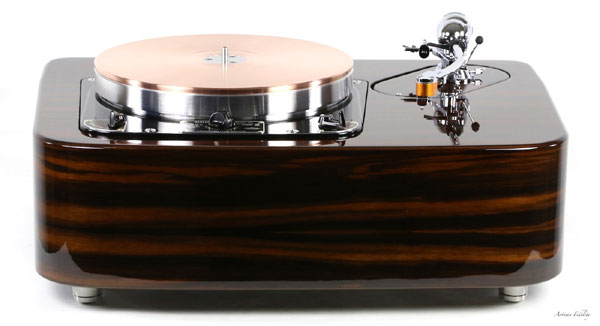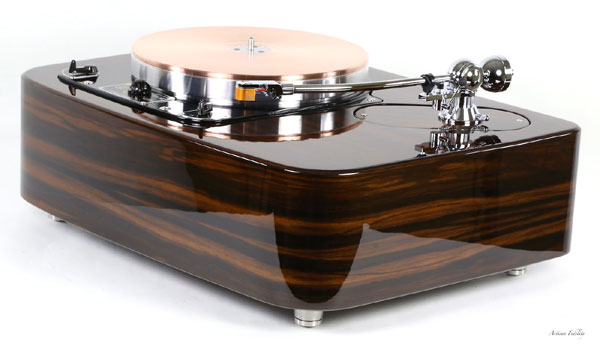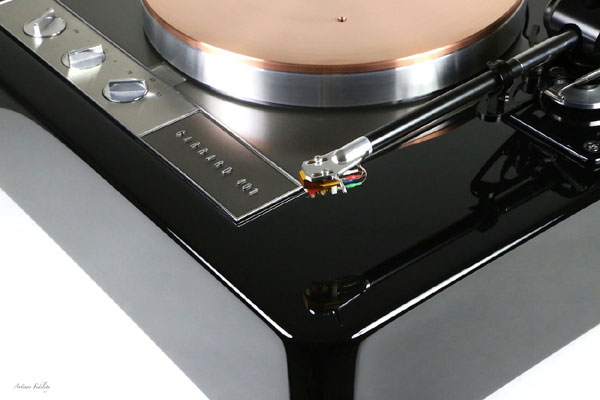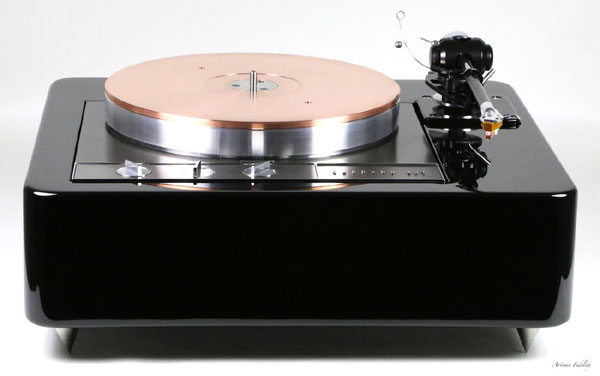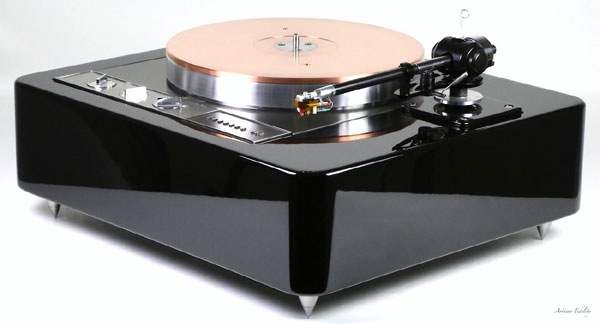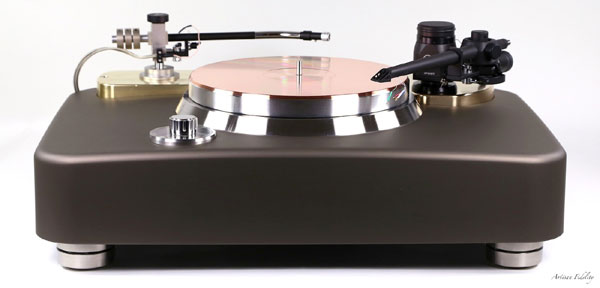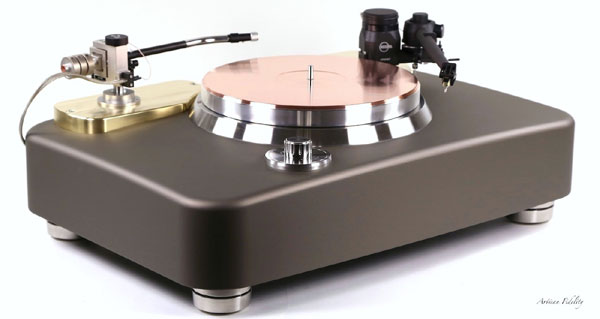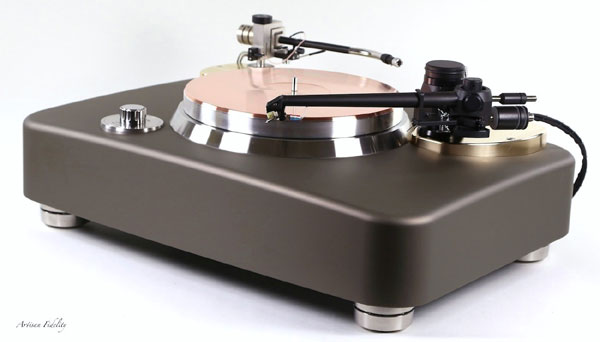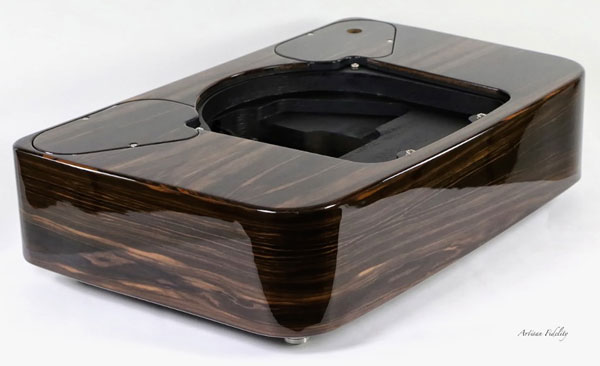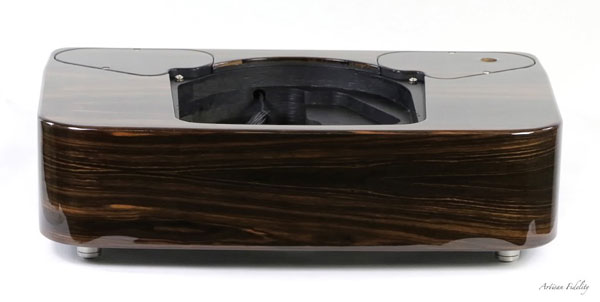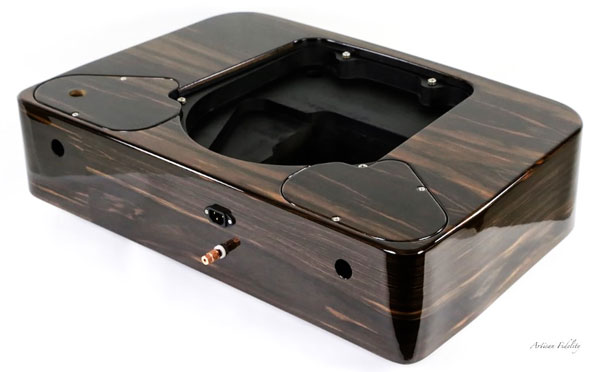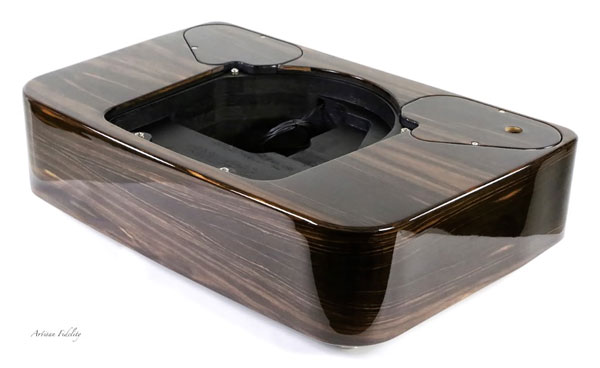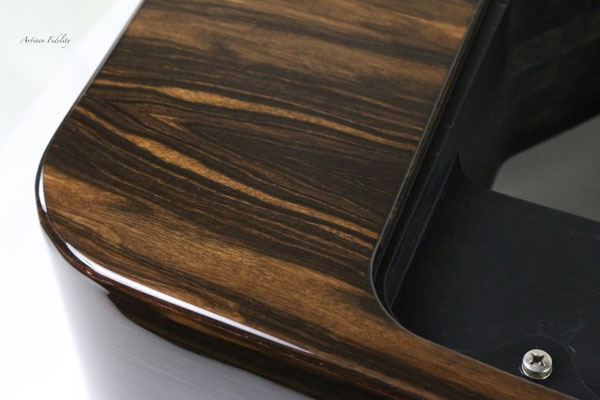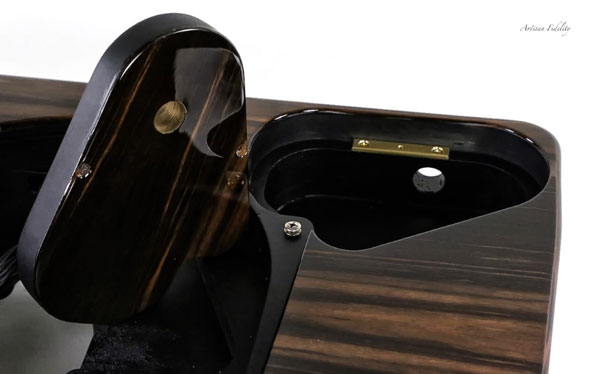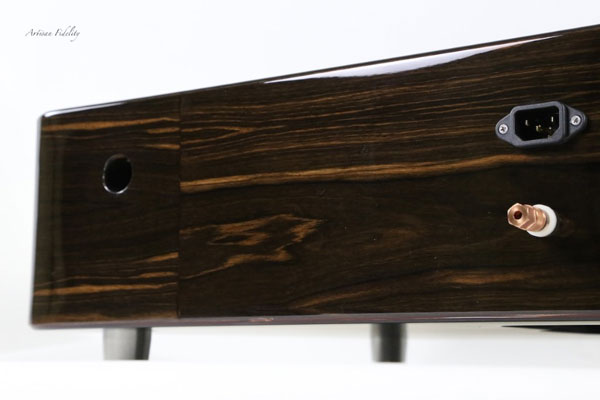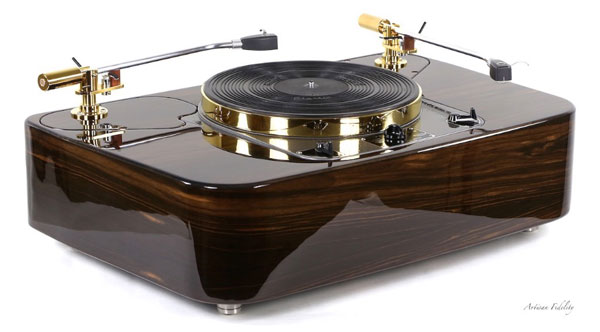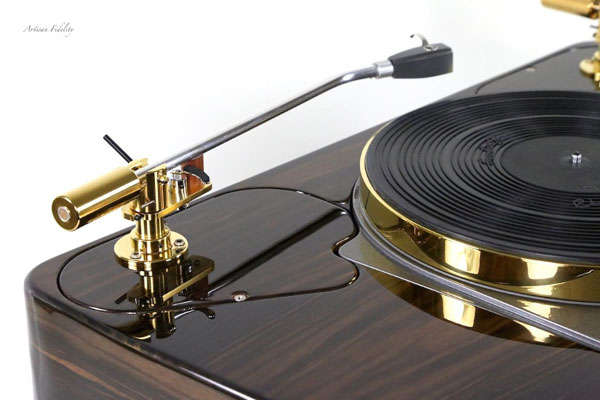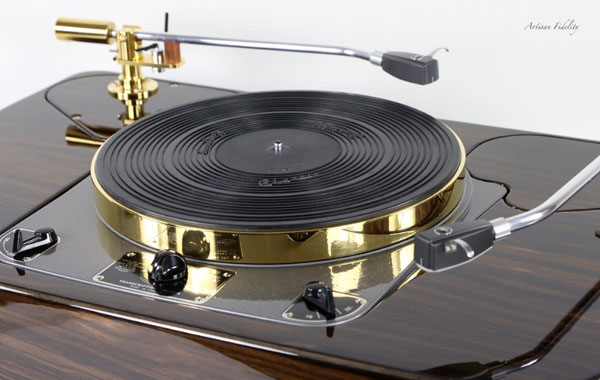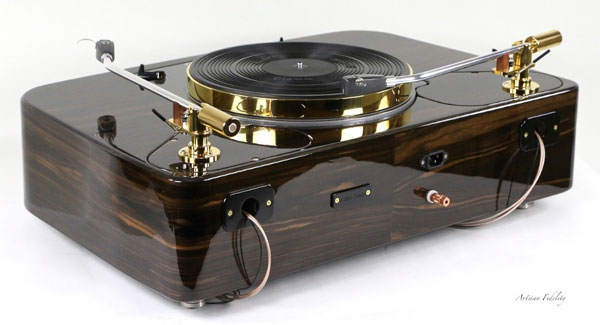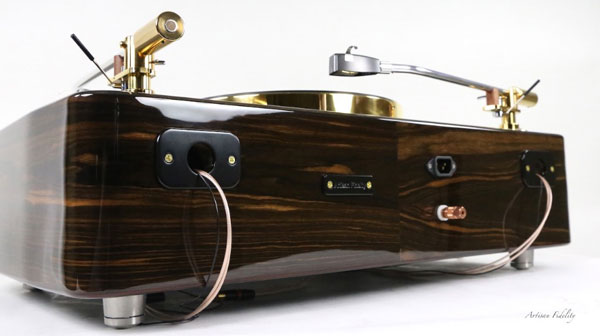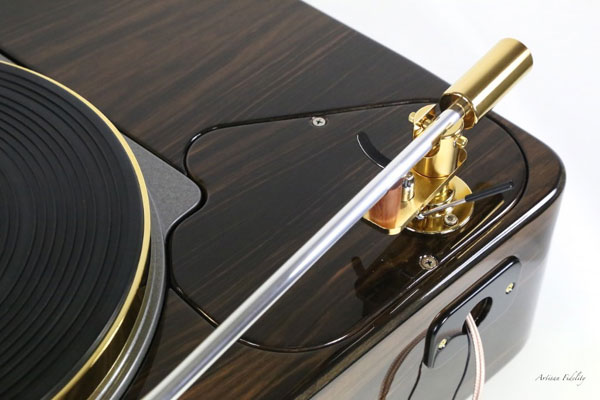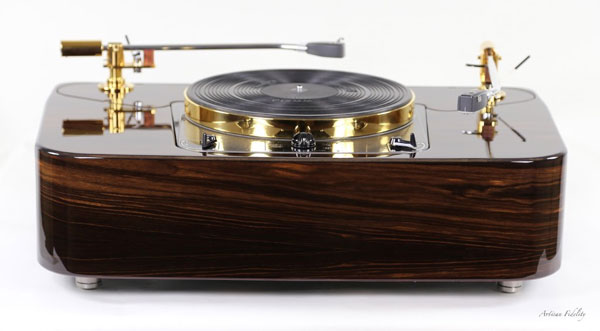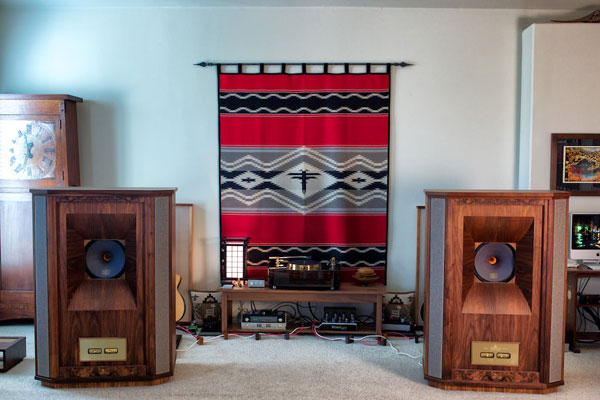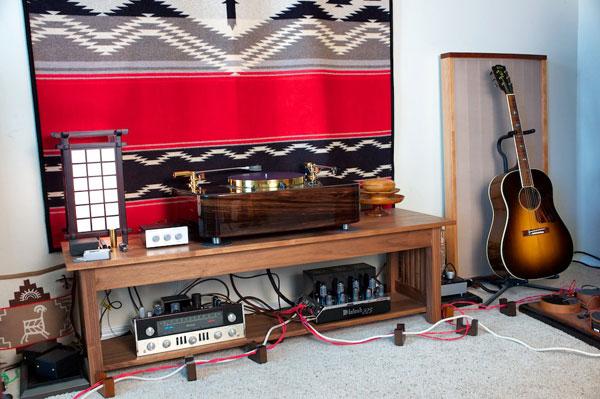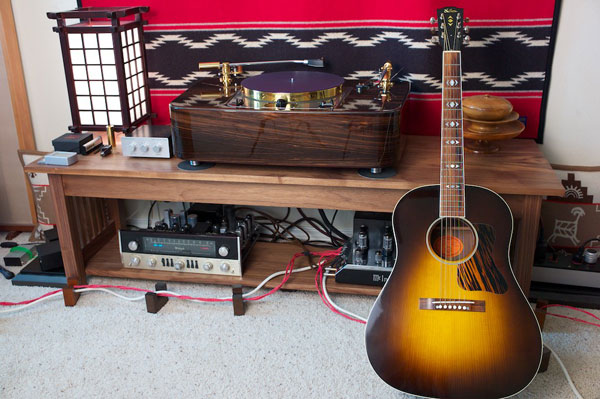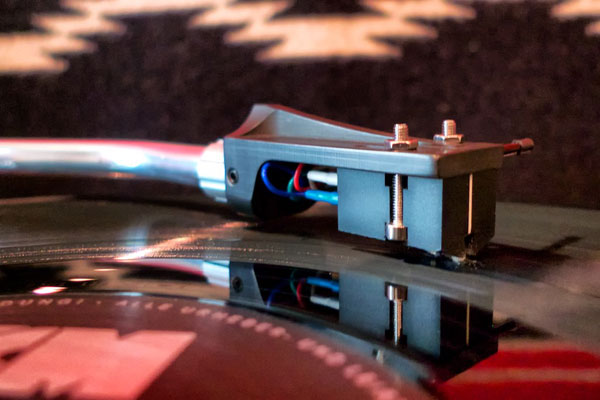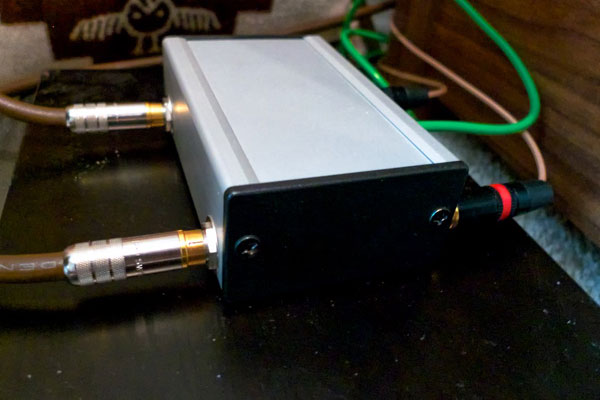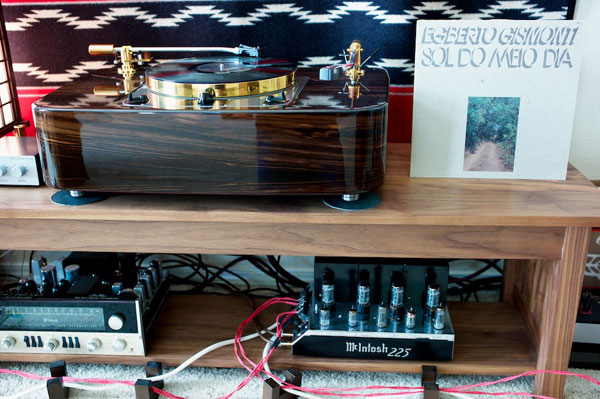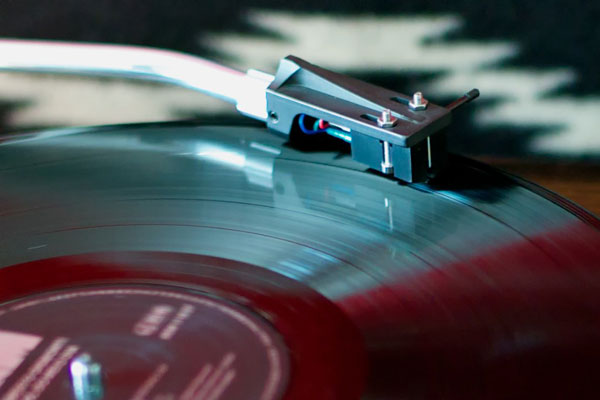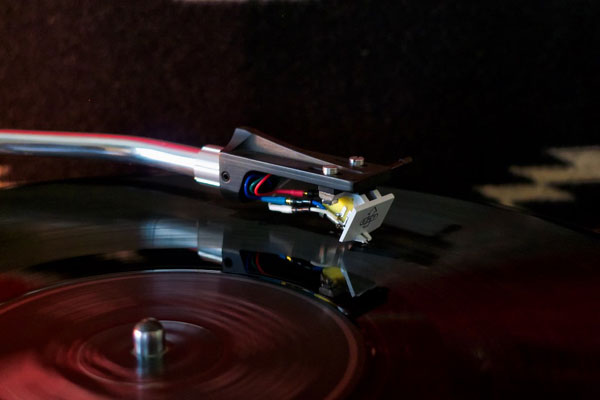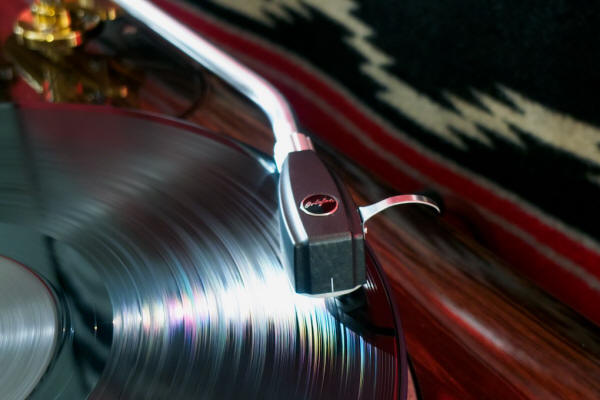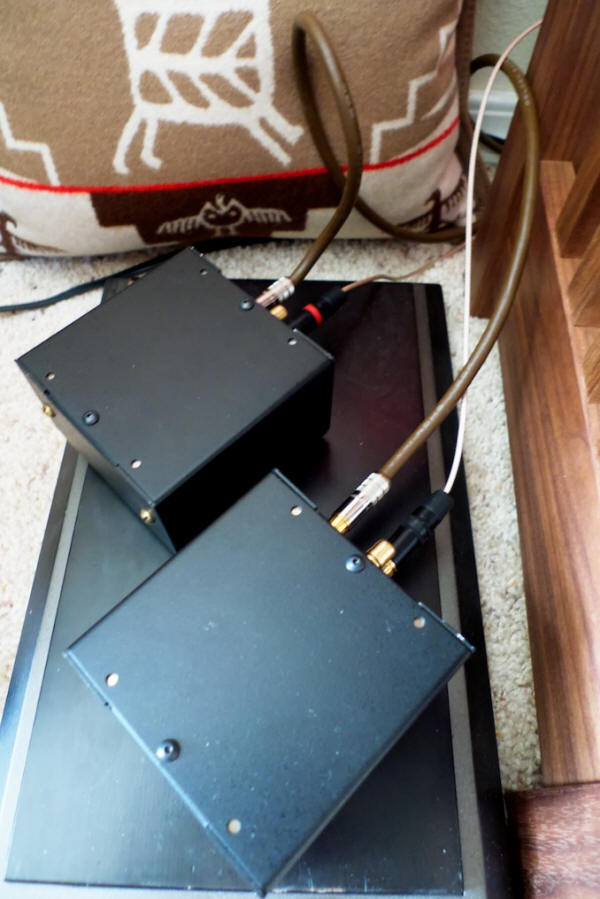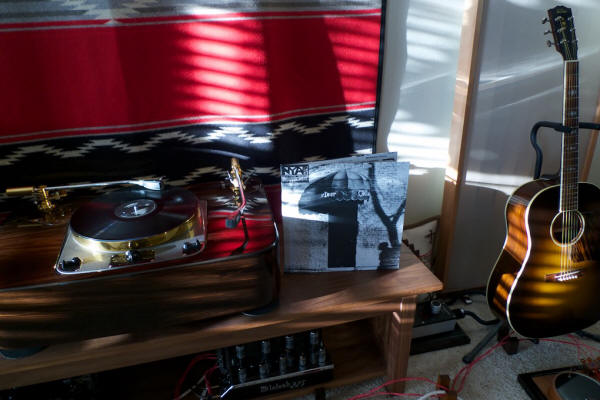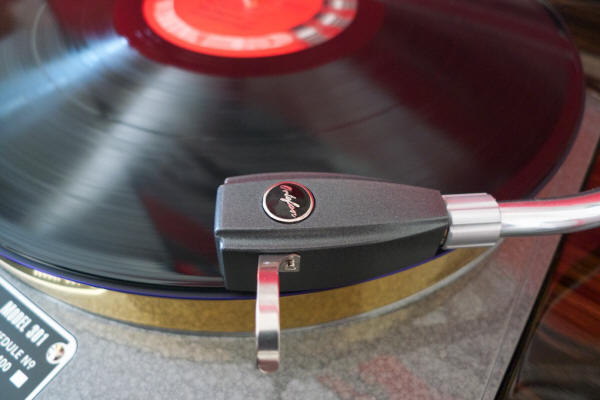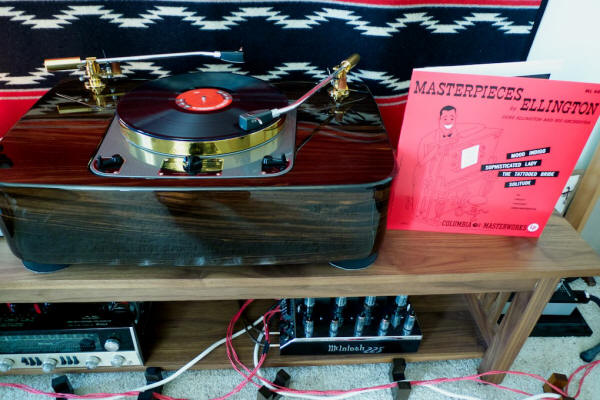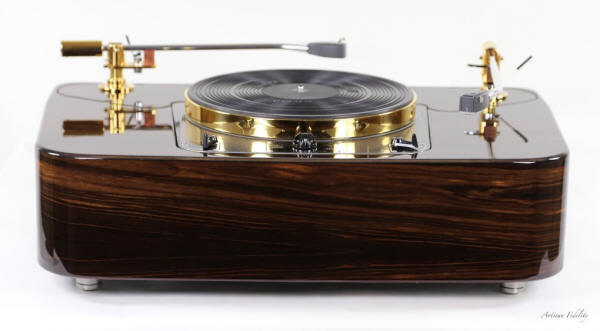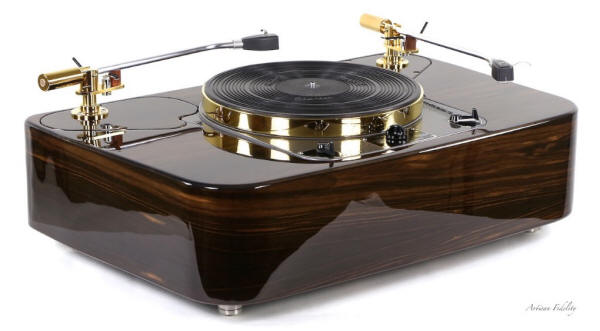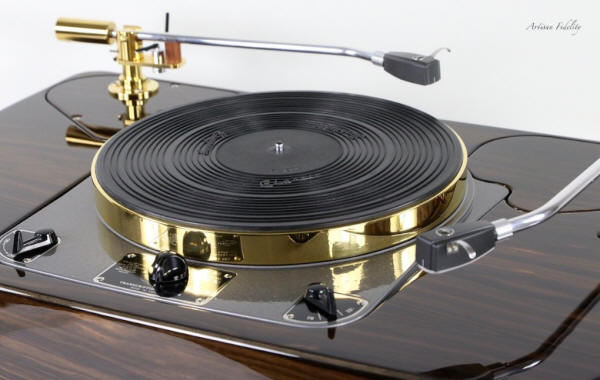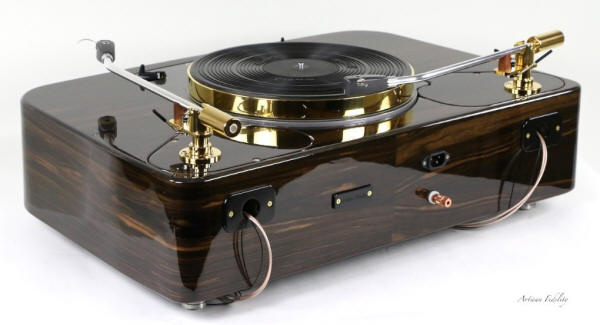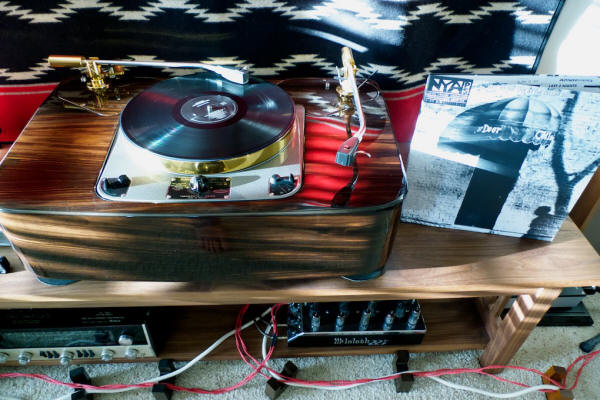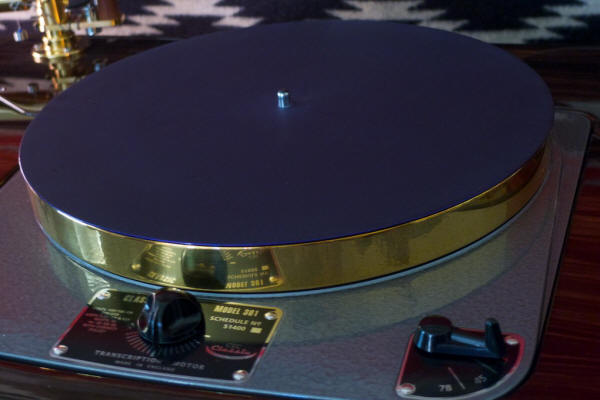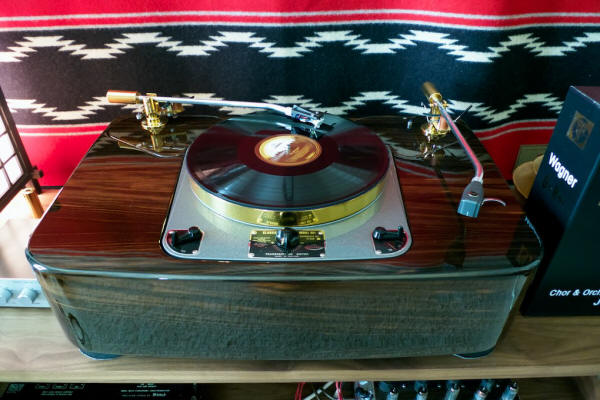You are reading the older HTML site
Positive Feedback ISSUE 79
The Garrard Project
2015: From Simple to Spectacular!
There's just something musically magical about the performance of idler-wheel Garrard transcription turntables that keeps me fascinated with them. Certainly the vintage Garrard 301 represents a beloved milestone of turntable design that remains enduringly popular with hi-fi enthusiasts to the present day, and who, like the 1956 Garrard advertisement below suggests, have concluded that Garrard is still among "The finest record-playing equipment in the world". (Allow me to thank the Local Studies & Family History Group at Swindon Central Library for the use of their archived vintage Garrard advertisements in the article thank you!)
A Brief 301 & 401 Centric History of Garrard The Garrard Engineering and Manufacturing Company, Ltd., in Swindon, England, manufactured the Garrard Model 301 Transcription Motor Unit from 1954 until 1965, when the Garrard Model 401 Transcription Motor Unit, which was produced until 1977, succeeded it. (Allow me to thank the Ray Clark of Classic Turntable Company for the use of his vintage Garrard photographs below thank you, Ray!)
The Garrard 301 & 401 were 'transcription turntables,' which means they were used in recording studios, radio, and television applications, and as such had to meet rigorous performance standards of "better than 0.1 per cent RMS for wow, 0.4 per cent RMS for flutter, and -40dB relative to 1cm/sec at 1kHz for rumble." As Mr. E.W. Mortimer, the Garrard Chief Engineer said, "This represented a very high standard, which is at least twice as that acceptable for the popular type of record playing unit" (E.W. Mortimer, Garrard Engineering Limited, Design of Transcription Turntables, circa 1967). There were running design changes to the Garrard 301 during its production to improve its performance and help quiet it down, like the oil bearing that was introduced in 1956, but ultimately Garrard produced a new modelthe 401with a new chassis, a new platter, a new motor assembly, and a new bearing thrust pad, as a solution for improved performance. The Garrard 401 looks quite different from the 301 due to the change in the shape of its chassis, yet the 401 still used a majority of the 301's well thought out design elements.
The intent for the 401 to be a higher-performance evolution of the 301 went astray, however, as the 401's improvements were offset by quality issues during its manufacture that led to it not performing as well overall as the 301. The consensus opinion is that the motor used in the 401 is superior to the motor used in the 301, and more than a few Garrard aficionados believe that the ultimate vintage Garrard would be a 301 with a 401 motor. Garrard as a profitable business started into a downward spiral in the late 1970s as it incurred significant financial losses, and in 1979 Garrard was sold to Gradiente in Brazil for a small fraction of its former value. As its financial troubles escalated, all Garrard production ceased in Swindon in 1982, which was a tragedy both for the people of Swindon, as well as for music lovers around the world. The Garrard brand name was not so easily erased from audio, as there were many enthusiasts who still cherished the Swindon manufactured Garrard 301s & 401s. One Garrard enthusiast & expert in particular, Terry O'Sullivan of Loricraft Audio, who had been servicing Garrard 301 & 401 transcription turntables since the 1980's, was determined to keep the Garrard brand name alive, and was able to obtain the rights to it from Gradiente in 1997. Thank you, Terry, for keeping the Garrard brand name alive!
The Six Moons Garrard Project The vintage Swindon manufactured Garrard 301 & 401 transcription turntables have always been "Garrard Projects" because you had to buy your own transcription motor unit, then mount it into a plinth (a base that houses the transcription motor unit), and then add your choice of tonearm & phono cartridge to the plinth, to build a 'player system'. Starting in 2004, I wrote a series of articles for Six Moons (1, 2, 3) about my first Garrard Project player system (photo below). In that first Garrard Project my plan was to keep it simple and as low cost as I could, to match my budget at the time. First I found a nice clean old Garrard 301, then Terry Cain built me a skeletal wood plinth for it, and Jonathan Halpern (Tone Imports) loaned mehis personal SME 3012 tonearm to use for the project. At Jonathan's recommendation, I added the classic Denon DL-103 phono cartridge, along with the Auditorium 23 step-up transformer, and the result was a very musical introduction to the world of vintage Garrards.
The Shindo Garrard 301 Player System Then in 2006 when I was visiting San Francisco for the 232nd American Chemical Society National Meeting, I was able to include a visit with Matthew & Keenya Rotunda, and their son Jared, who are the family part of their family-owned business, Pitch Perfect Audio, a musical oasis then in SOMA (since moved to Los Angeles).
Matt and family That evening of listening to music with Matt, Keenya and Jared, was one of my most enjoyable audio experiences, and the one where Matt introduced me to the spectacular Shindo Garrard 301 Player System, which handily outperformed my simple but musical Garrard Project player system.
Shindo player at Matt's The Shindo Labs 301 Player System was certainly one of the most beautifully crafted turnkey implementations of a vintage Garrard 301 that has ever been offered as a commercial product, and has long been a benchmark of inspiration for many Garrard enthusiasts. Ken Shindo refined his Garrard 301 Player System over the decades and left very little untouched: a custom tonearm, tonearm base, SPU cartridge, oversized heavy platter, bearing & spindle, record mat, record weight, a beautiful layered & lacquered cherry plinth, isolation feet, and silver tone arm interconnects, all voiced to deliver a musical knockout. The Shindo Garrard 301 Player System was a superb turnkey approach to a Garrard 301 player system (Jonathan Halpern of Tone Importsthe North American importer for Shindo productsinformed me when I checked about the Shindo Garrard 301 Player System's current retail price for this article, that it was not currently in production). The last retail price of the Shindo Garrard 301 Player System I found was in Jack Robert's excellent November 2010 review, where the retail price was given as $25,000 USD. My Vision for the Garrard Project 2015 Player System As I began to formulate a plan for what I would like to do for the Garrard Project 2015, I began to consider the spectrum of possibilities, and do a little research. I wanted to build the nicest Garrard 301 player system possible, with a final price tag that was more than the original Garrard Project I wrote about for Six Moons, but one that was considerably less than the $25,000 USD Shindo Garrard 301 Player system.
Garrard 301 In preparing for the project, I did enough research to get an understanding of the consensus of opinion among vintage Garrard aficionados about what the most important performance considerations were for getting the most out of a Garrard 301, and in a similar vein, I wanted to understand what Garrard's own view was about improving on the performance limitations of the 301 design when they designed the 401.
Garrard 401 top view Garrard maintained much of the 301's desirable DNA (if it ain't broke, don't fix it) in the 401, but they also wanted to "fix what was broke" in the 301, which meant upgrading the 301's flexible chassis, its vibration-prone platter, building a quieter motor, and implementing a new bearing thrust pad, which were all deemed necessary design changes to improve on the 301's performance.
Garrard 401 bottom view I found that reading the circa 1967 paper by Garrard's Chief Engineer, E.W. Mortimer, Design of Transcription Turntables, about the design of the Garrard 401, to be illuminating and fascinating. Unfortunately Garrard's design insights into making a better 301 via the 401 were derailed when quality issues in their manufacturing of the 401 largely kept the benefit of those intended performance improvements from being realized. More than a few Garrard aficionados believe that the ultimate vintage Garrard would be a 301 with a 401 motor, but in light of the Garrard's Chief Engineer's intended performance upgrades for the 401, it seemed to me that an ultimate vintage Garrard would have to address all of those identified performance upgrades as well. So my baseline vision for the Garrard Project 2015 became a 301 with a 401 motor, but with the issues of the flexible chassis, vibration-prone platter, and a better spindle & bearing design, all addressed.
Garrard 301 left angle view Many Garrard enthusiasts (including me) love the looks of the 301's curvaceous chassis (above), and I think it is a winner of visual design, but it was also a flexi-flier that limited the 301's performance potential. The original 301's cast aluminum chassis wasn't adequately rigid where the bearing bolts to the chassis, and you can actually flex it by hand.
Garrard 301 cast chassis
Where the bearing bolts to the chassis of the 301 I think the Garrard 401's larger, squarish, diecast & ribbed aluminum chassis that was designed to address the flexi-flier nature of the 301 looks ok, but I still like the looks of the 301's curvy chassis better. So for my ultimate vintage Garrard I want the looks of a 301 while correcting the flex & bearing mount issues the chassis has.
Garrard 301 cast chassis bottom view with hardware Garrard did a cast chassis for the 301, but since we're not limited to 1950s technology in 2015, I'll choose a computer numerical control (CNC) machined chassis out of a solid slab of aluminum, with computer-aided design (CAD)/computer-aided manufacturing (CAM) software implementing the design improvements needed to correct the original 301 chassis' structural issues, while maintaining the aesthetic beauty of its design.
301 cast platter
Close-up of holes in 301 platter Another weaknesses of the 301's design was that the cast platter had issues related to porosity & flaws within the casting. The casting tolerances of those original platters were a little 'loose' by modern standards, as they weren't a consistent thickness, so they were out-of-balance. Those out-of-balance platters would vibrate excessively while spinning if used as-is, so Garrard drilled holes into them to balance them better so they wouldn't vibrate excessively, minimizing the sound quality degradation caused by a vibrating platter.
Garrard 401 platter As I understand it, Garrard did attempt to improve the platter a bit when going from the 301 to 401, as E.W. Mortimer mentioned in his paper Design of Transcription Turntables, where he described the 401 platter as "a casting which is almost free from porosity or blow holes." However, like the 301 it was still cast and vibrated enough to require balancing "by drilling recesses on the underside of the rim in appropriate positions to correct any out-of-balance which may be caused by variations in the density of the metal casting." So for my ultimate Garrard I'll just toss the Garrard cast platter and replace it with something better. I'll keep in mind Mr. Mortimer's recommendation that "Additional weight is also an advantage in improving stability and constancy of speed. The ultimate turntable is, therefore, a reasonably homogenous mass requiring a minimum of attention in order to achieve near perfect balance, providing that the machining operations are carefully controlled," and so once again I'll turn to CAD/CAM and CNC machine a slab of aluminum into a perfectly balanced oversize platter with higher mass. Garrard 301 Motor
Garrard improved the motor assembly of the 401 to the point that it was on par with most of the cutting lathes of the time in terms of rumble, wow, and flutter. The 301's motor was good too, but the 401's was quite a bit better, which is why those afore mentioned Garrard aficionados chose a 401 motor assembly for their hypothetical ultimate vintage Garrard, and I'll do the same. Garrard replaced the aluminum motor housing of the 301 with a heavy cast iron housing in the 401 to help reduce vibration of the electric motor, and to provide magnetic screening. By the way, in addition to Mr. Mortimer's paper, Design of Transcription Turntables, there's an excellent discussion about why the 401's motor is better than the 301's by Nigel Pearson, out on Terry O'Sullivan's website, here. Garrard 401 Motor
The other item that Garrard improved in the 401 over the 301 was the bearing thrust pad. However, as Mr. Mortimer pointed out in the Design of Transcription Turntables, "The performance of the whole unit mainly depends upon the accuracy of the turntable spindle assembly which, therefore, requires special attention." So for my ultimate vintage Garrard I'd want to go even further and build a precision and more robust spindle and bearing assembly to go with my oversized & more massive platter. So where did I finally end up with my vision for an ultimate Garrard 301 transcription turntable? Essentially with the Garrard aficionados' Garrard 301 updated with a 401 motor, but with the improvements of a new non-flexible chassis, an oversized & perfectly balanced platter, spinning on a precision spindle assembly uprated for the heavier platter, all of which are improvements in keeping with the spirit of Mr. E. W. Mortimer's 401 upgrades from the 301 for improved performance. The Plinth With my vision of an ultimate Garrard 301 transcription turntable in mind, I turned my imagination to the kind of a plinth I'd like to install it into. I've heard a lot of Garrards in various styles of plinths over the last eleven years since my first Garrard project, and my favorites have been those that are built up in wood layers, and fit the Garrard like a glove (like the Shindo plinth, for example). I thought those plinth designs provided the best balance of realistic timbral textures, deep tone colors, explosive drive, and rich musicality that I crave from the Garrard 301. I also wanted my plinth to accommodate two tonearms; one tonearm for a monaural cartridge, and one tonearm for a stereo cartridge, so I could listen to my favorite mono & stereo records on the fly, without having to stop and change cartridges. I also knew I wanted my plinth to be veneered beautifully, with a finish that rivaled my Adirondack Spruce & Brazilian Rosewood Gibson Custom Shop Advanced Jumbo guitar, so that the Garrard Project 2015 would look more like the curvaceous, beautifully finished, musical instrument I wanted it to be, rather than the more rustic look of my first Garrard project. The Tonearms For tonearms, I wanted quality-crafted, 12-inch transcription-style tonearms of moderate mass to accommodate the low compliance Ortofon SPU cartridges I wanted to try, my low-compliance Denon DL-103 phono cartridge, and my medium compliance EMT TSD-15N SFL phono cartridge. Ok, let me sum up what I've come up with for my Garrard Project 2015 player system: I wanted a player system with a Garrard 301 transcription turntable using a 401 motor, a non-flexible chassis, an oversized, high mass, and perfectly balanced platter, spinning on a high quality spindle assembly uprated for the heavy platter. To get the best out of my ultimate Garrard 301, I wanted a two-tonearm plinth built up from layers of wood that fit the Garrard 301 like a glove, finished as beautifully as my custom Gibson Advanced Jumbo guitar, and mounted with two 12-inch transcription-style tonearms that would get the best out of the planned Ortofon SPU Mono CG 25 Di MKII cartridge & Ortofon SPU Classic GM MKII stereo cartridge, and my classic Denon DL-103 & EMT TSD-15N SFL cartridges. The Garrard Project 2015 Player System One thing that was apparent in my research was that in the eleven years since I wrote about my first Garrard Project player system, there are now quite a few more individuals doing beautiful restorations and modifications for Garrards, building plinths, and even crafting SPU compatible tonearms, than there were back in 2004. It is a good time to be alive for Garrard aficionados. As I surveyed the world, I was particularly impressed with the work done by fine audio constructeurs Ray Clark (Classic Turntable Company), Christopher Thornton (Artisan Fidelity), and Thomas Schick (Thomas Schick), so I contacted them to tell them about my idea for a Garrard Project 2015 to see if they'd like to join the project team. To my delight they all said, "Yes!" The Garrard Project 2015 Project Team Now let me take some time to introduce you to Ray Clark, Thomas Schick, and Christopher Thornton, and tell you about their contributions to the Garrard Project 2015 player system. Ray Clark of Classic Turntable Company As you might suspect, Ray is a major Garrard enthusiast, and has been specializing in servicing & upgrading Garrard 301s at his Classic Turntable Company in the village of Midgley, West Yorkshire, England, for about ten years. Ray offers a full range of services, from providing spare parts for your 301 or 401, complete 301 or 401 restorations, and high-performance modifications that take a vintage Garrard to spectacular heights. CTC Garrard 301 Restoration
Rstored Garrard 301 top no platter
CTC restored Garrard 301 bottom
CTC restored Garrard 301 top angle view I asked Ray to tell me about how his passion for hi-fi got started, what led to his interest in Garrards, and what led him to start his Garrard-centric Classic Turntable Company: "My Dad bought a Murphy Radiogram in the early 1950s, which was one of the first stereo units, and I was 3-years old at the time. I was fascinated by the autochanger, and I used to watch it play ten singles at a time. My parents bought me my own record player at 4-years old, but it was a non-autochanger that looked a bit like the 301, but was a cheap plastic player. My parents were not prepared for when I pushed it away, and would not touch it, because it wouldn't change records. I was so distraught that they bought me an autochanger like my Dad's. I'd like to say I had a Garrard all my life, but that's not strictly true. I had a basic Garrard until I was 11-years old, and then I made my own separates system using a Garrard SP25 MK 1, which in that day was a great deck. I had the SP25 until I was 17-years old, and then I bought my first proper stereo. I had always wanted a Thorens, but could never afford one. I once brought home a Thorens TD150 MK 2, and my Dad said, "You can't afford that!" and made me take it back." Ray went on to say, "I have always been a reel-to-reel tape recorder addict too, and I've had a reel-to-reel all my life. I had what was then considered a good deck, the Akai 4000D. I was amazed at how good the sound quality was, and I could tell when they were not performing correctly, and so started working on them. Then for many years I serviced tape decks, and also sold them after rebuilding them." "Having kids, as most folks do, means you can't sit and listen to music as one used to do before they came on the scene, and so from 35-years old to 55-years old I did very little with hi-fi. I have another business, called Echelon Sport, which manufacturers sporting goods. My business partner, Steve Cole, and I both used to be employees there, and we wanted to preserve the long tradition of British shuttlecock manufacturing, so we bought Echelon Sport from Dunlop Slazenger, who wanted out of manufacturing. That was 15 years ago, and with the business doing very well I decided to buy a bigger house that came with a big mortgage. I bought it at the height of the property boom, and no sooner than we bought the big house the markets crashed, with the collapse of the big banks, and very soon after that the business was not making as much money as I'd hoped. It was a crisis!" "To get by one Christmas we decided to weigh in some scrap metal at the local merchants. When we arrived, the place was closed, but there was a queue of gypsies who scoured the streets. As I was waiting, I looked into the back of the lorry in front of me, and I saw what looked like a record player. I decided to take a closer look, and to my amazement it was a Thorens TD150 MK2! I could not believe it, so I asked the driver if I could buy it, and he quite willingly gave it to me. He said, "Take it lad, if it's of any use to you." The platter was not visible, but he knew where it was, and dug down for it. I took it home, and there was nothing at all wrong with it so I cleaned it up and used it. This event re-sparked my enthusiasm for hi-fi, and I later sold the Thorens for a profit." "I got into the Garrards by mending a friend's, and after testing it I was amazed at how good it was. I noticed the weakness of the chassis, and how poor the design was, and how the 401 had made efforts to make the chassis stronger. I just did not like the 401's shape, but I liked the curvy 301. So I used the tool company who made our shuttlecock molds to make me a prototype of a stronger 301 chassis, which led to me starting the Classic Turntable Company, and the rest is history!" Classic Turntable Company Products Overview Ray offers a variety of products & services through his Classic Turntable Company, including refurbishment services for Garrard 301s & 401s; Garrard 301 & 401 replacement parts; SMD Acoustics Type II plinths for 301s & 401s; upgrades like chromed or gold plated control levers, CNC machined oversized aluminum or brass platters, spindle thrust bases, and external speed controllers; and the Classic Turntable Company 301 turntable that is a combination of new upgraded components and refurbished Garrard components. CTC Refurbished Garrard 301
CTC refurbished Garrard 301 on box Ray's experience in manufacturing with his company, Echelon Sport, and his access to CAD/CAM and CNC machines to make upgraded parts for the Garrard 301 & 401 a real boon to Garrard enthusiasts. Ray offers two models of hot-rodded Garrard 301s: the Classic 301 Standard, and the Classic 301 Studio Reference.
Classic 301 Standard on box The Classic 301 Standard (£2,499 GBP) One of the reasons I was so excited to have Ray on the project team was that his Classic 301 Standard transcription turntable was virtually identical to what I envisioned as my ultimate Garrard 301. When I saw and read about the Classic 301, my mouth dropped open in surprise, and I uttered an 'Oh yeah!" The Classic 301 Standard is not cheap at $3729 USD, but when you find out what goes into making one, like me, I think you'll come to the conclusion that it's a fair price.
Classic 301 Standard angle view Ray essentially takes the Garrard aficionados approach of making an ultimate vintage Garrard 301 transcription turntable by replacing its motor with a 401 motor, but he also does a lot more than that, because he replaces the stock flexi-flier chassis with a state-of-art CNC machined non-flexible aluminum chassis, then CNC machines an oversized, high-mass, and perfectly balanced aluminum platter to replace the stock platter, and then builds a custom stainless steel oil-bearing spindle assembly that has been uprated specifically for the heavier platter.
Classic 301 Standard bottom view To upgrade the original chassis' design, Ray CNC machines a new rigid chassis from a solid slab of aluminum that eliminates the bearing mount weak point and the flexiness of the original chassis, which improves performance while maintaining the original Garrard 301's attractive curves.
Slab of Al for CTC 301 chassis
CNC Classic 301 chassis The original 301 has mounting holes that go down through the top of the chassis so you can bolt or screw it to a plinth, which is a bit unsightly, and scuffs up the paint around the mounting holes. So instead of machining mounting holes down through the gorgeous CNC machined chassis, Ray includes one of the upgrades from the 401 chassis design, and adds the mounting stud inserts into to the bottom of the chassis, keeping the top of the chassis clean from mounting screw heads sticking up out of it. I think it's a nice improvement to the looks of the chassis to have the mounting points underneath.
CNC CTC Al platter For the Classic 301 Standard version of a Garrard 301, Ray CNC machines a platter from perfect consistency solid aluminum bar stock to tolerances better than two thousandths of an inch, and it is 7mm bigger in diameter than the original platter. The CTC CNC machined platter is as perfectly balanced as can be achieved with modern state-of-art CNC machinery, and gives a smooth perfect spin that improves sound quality. Ray says, "The extra diameter and extra mass (a standard cast Garrard platter is 2430 grams, the oversized CTC CNC machined platter weights 420 grams more) greatly improves the platters inertia and this results in added bass delivery, stability of imaging, etc., and it has so much energy in rotation that it takes a lot to stop it spinning."
Bottom view of hardware on CTC 301 Standard Ray's manufacturing experience also allows him to manufacture all new hardware, linkages, fascia plates, etc., to replicate the classic Garrard parts, but improve upon them with modern engineering techniques. The Classic 301 Standard is available in your choice of Hammertone, Cream, or Black finishes (with other finishes by request). The Classic 301 Studio Reference (£4,500 GBP) The Classic 301 Studio Reference is called the 'Studio Reference' because recording studios have been ordering them of late. The Classic 301 Studio Reference has a couple of upgrades that make me weak in the knees they're so nice!
Photo 32 CTC 301 SR with brass chassis Like with Classic 301 Standard, Ray takes the Garrard aficionados approach of making an ultimate vintage Garrard 301 transcription turntable by replacing its motor with a 401 motor, but he diverges from the Standard by CNC machining the Studio Reference's chassis out of brass instead of aluminum! Brass is almost four times heavier than aluminum, so in addition to the CNC machined chassis you get the added benefit of mass to reduce vibration, as well as the beautiful appearance of brass, and like the Standard chassis, Ray adds the mounting stud inserts into to the bottom of the Studio Reference's chassis, giving the top of the chassis a cleaner appearance.
CNC brass platter For the Classic 301 Studio Reference Ray CNC machines a platter from solid brass to tolerances better than two thousandths of an inch. Ray says, "The finished platter is polished on the edges then gold plated to a mirror finish to prevent finger marks." Ray says he likes to use brass for a platter because, "Solid brass is virtually free of any defects and thus perfect for a turntable platter." Like the CNC machined aluminum platter of the Standard model, the CNC machined brass platter is 7mm greater in diameter compared to an original platter, and weighs a massive 10 kilograms, which about 4 times the mass of an original platter. Ray says, "The difference is staggering, the extra mass greatly improves the platters inertia and results in even better quality of bass delivery, stability of imaging, etc." To accommodate that massive brass platter, the Classic 301 Studio Reference uses an oversize brass grease bearing. As with the Classic 301 Standard, for the Classic 301 Studio Reference Ray also manufactures all new hardware, linkages, fascia plates, etc., to replicate the classic Garrard parts, but improves them with modern engineering techniques. The Classic 301 Studio Reference is finished in polished brass, and clear coated to protect it. Other finishes are available by request. The Garrard Project 2015 Classic 301 (£3,150 GBP) For the Garrard Project 2015 player system I chose to go with the Classic 301 Standard, finished in Hammertone, with an upgrade to the brass platter & uprated spindle of the Studio Reference. Thomas Schick (Thomas Schick) Thomas Schick manufactures custom tonearms suitable for a variety of low- and medium-compliance phonograph cartridges, graphite head-shells, and an exotic plinth, all of which are handmade in Germany in the fine audio constructeur tradition. I asked Thomas to tell me a little about how he came by his love of music and hi-fi, and how his company got started: "Through my older brothers and sister I got interested in music pretty early. In the 1970s they listened to Krautrock, Jazzrock, Deep Purple, Pink Floyd, Ike & Tina Turner, and the like. I was a 'passive listener'. I did not know what was what at the time, but I remember those songs, which were playing all the time in our house." "One of my brothers had a summer job and bought a Pioneer, JBL stereo from the money earned. I was awed and infected. My first own stereo was an old tube radio and we had a tube-powered jukebox from 'Rock-Ola' as well. Little did I know that this was actually really good sounding." "I bought a Garrard 301 and restored it. Then I was looking for a 12-inch tonearm. I had two other arms, both of which I was not very happy with, their tonality was nice but they didn't sound very dynamic or precise. The sound was 'slow'. So I started to work on a better alternative, based on the experiences I have gathered so far. I built my first tonearm in 2005." "The prototype was part of my setup at the European Triode Festival (ETF). ETF is a do-it-yourself (DIY) vacuum tube audio gathering inspired by the Sound Practices mailing list. My first tonearm was not intended as product, it was simply part of my setup for ETF. The arm received a lot of positive comments at the Festival, and a woman asked me to make one like it for her husband. That was my first 'sale'. From a blog article, and by word of mouth, more and more orders came in. Finally, I gave up my job in the broadcast industry, and now it is fulltime analog audio." At home Thomas has been listening to a Klangfilm horn loudspeaker system (the Siemens Eurodyn), powered by vacuum tube amplification, and he enjoys a number of idler wheel or direct drive broadcast turntables, including a Garrard 301, a Commonwealth 12D3, an EMT 950, a plastic Sony 'Biotracer' from the 1980s, and the prototype of a turntable he is developing and will be selling in the near future. As for the subject of this article, Garrard 301s & 401s, Thomas says, "For me the Garrard 301 and 401 are pretty high on the shortlist for best sounding record players." Thomas tells me he's also building a new pair speakers, a straight horn system inspired by large Western Electric or Sato-style installations. Thomas' listening room allows him to install a straight (i.e. non-folded) 2.1-meter long horn underneath his roof, with a 1.3-meter by 1.3-meter mouth area, which will be driven with a compression driver. Sounds fun! For quality assurance testing of his tonearms, Thomas uses Klein & Hummel O92 studio monitors, with a DIY tube phono stage, and a broadcast line level control, reflecting his background in the broadcast industry. Thomas says it's all 'German broadcast technology' and actually sounds pretty good. Thomas Schick Products Overview
The Thomas Schick Tonearm (1160 base price) Thomas builds moderate mass tonearms that are an excellent match to all phonograph cartridges below a compliance value of 20 µm/mN (22µm/mN for the 9.6-inch version of the Thomas Schick tonearm). This works well for the low-compliance phonograph cartridges (5-10 µm/mN) I use, like the Ortofon SPUs (my Ortofon SPU Classic GM Mk II is 8 µm/mN) and the Denon DL-103 (5 µm/mN), and medium-compliance phono cartridges like the EMT TSD-15N (15 µm/mN), which has been a long-term reference of mine. Thomas says, "The 12-inch tonearm is suitable for any cartridge from about 6 grams, and a compliance value of below 20 µm/mN (22µm/mN for the 9.6-inch version). That includes most cartridges on the market, excluded are only lightweight and very soft MM systems. With cartridges up to a compliance value of 20µm/mN you get a favorable tonearm resonance in the area of 8-11Hz." Thomas' tonearms have a pivot-to-spindle distance of 12-inches, so in reality they are descendants of the broadcast-style arms developed for playing 16-inch records, reflecting Thomas' experience in the broadcast industry. Thomas points out that 12-inch tonearms offer less tracking distortion than shorter arms, so they can sound better when properly setup, which is one of the reasons for their enduring popularity among enthusiasts of vinyl playback. You can order Thomas' tonearms in a version optimized for use with a universal headshell and SPU-G phono cartridges (the 'normal' version, which is what I used for the Garrard Project 2015, and accounts for almost all the tonearms Thomas sells), and a specialty version for use with vintage SPU-A phono cartridges. Thomas makes the SPU-A arms on special request, and they are compatible with the vintage two pin arrangement, best known from vintage Ortofon cartridges. Thomas says, "These are wired to take EMT stereo as well. This version requires more work, so it costs slightly more. The 'right' channel carries the mono signal in that case. Most customers buy a regular G-type arm and use adaptors for their exotic cartridges." The 9.6-inch version of Thomas' tonearm is a drop in replacement for EMT 929 tonearms. Lest those who need to use shorter tonearms worry, Thomas says that the benefits of a 9.6-inch tonearm are less resonances due to the shorter arm tube, and less moving mass, and that tracking distortion with his 9.6-inch tonearm is very small. Thomas says the bearings used in vintage tonearms are their limiting factor, "If the tonearm is loose here, all the punch of the music is lost in the movements of the bearing. The needle is supposed to work as generator, creating electrical signals from the movement of the needle. If the arm assembly is able to move against that, it is hardly a good thing." Thomas eschews the use of the 'loose' bearings common in vintage tonearms, and instead uses high-tech bearings with a tolerance of zero micron positive, 7 micron negative, and which are designed to withstand continuous use at 100,000 rpm, so he not only achieves state-of-art performance, but also long-term reliability. Note: The base price given above reflects the pricing of the standard SPU-G tonearm at the time I bought the tonearms for this article, but Thomas' tonearm pricing varies somewhat dependent upon changes in the market prices of materials, the amount of handcrafting involved for individual models, and the options chosen.
Thomas makes his armtubes out of aluminum, polished to a high gloss, and damps them internally with materials selected by ear for the best sound quality. The arm hardware is CNC machined from brass with a special tool to give a surface called 'feinst gedreht' which Thomas says translates to 'finest lathing surface' in English, which gives a nice finish pattern on the parts. The arm finish is available in a gold-plated version, a silver version (Nickel/Palladium), or a black version that "is 'Black Chrome' like the old Leica cameras," with the latter two having a matte finish. Thomas' tonearms have integral interconnects terminated with RCA connectors and a ground wire, so you don't have to worry about buying a set of extra interconnects for his tonearms, which I really like. Thomas prefers fixed cables as it "avoids an additional contact interface with its resistances and possible problems."
The azimuth of Thomas' tonearms is adjustable via a setscrew on the SME standard headshell connector, so you can rotate the phono cartridge or universal headshell in the mount slightly to achieve the correct position. The VTA and tracking force are adjustable via Allen screws on the base and weight, respectively. Thomas makes two weights, one lighter and one heavier, to accommodate phono cartridges of varying mass (e.g. the heavy weight for heavy cartridges like my Ortofon SPUs, and a lighter weight for cartridges like my Denon DL-103 or EMT TSD-15N). There is a fair amount of debate about whether 12-inch tonearms benefit from anti-skate or not, but Thomas includes a bracket and counterweight so you can experiment with anti-skate, and decide for yourself whether you think it sounds better (for example, the VPI Classic 4 turntable manual says, "VPI has conducted careful listening tests and determined that every tonearm we tried sounded better with its mechanical anti-skating disabled and the tracking force very slightly increased.")
Thomas' arm lift works superbly, smoothly lowering the cartridge to the record's surface. The Thomas Schick Graphite Headshell (250) Thomas also offers a CNC machined high-density graphite headshell that is oil-soaked and sealed with a protective finish, and weighs in at 15.4-grams. The Thomas Schick Graphite Headshell has a finger lift, quality headshell wires, a gold-plated SME connector, and a set of cartridge mounting screws.
Thomas says the graphite headshell is extremely rigid and resonance free, and provides lots of detail, while maintaining truth-of-timbre and timing. (Note: pricing of the headshell can vary somewhat depending on the current market prices for materials.)
The Thomas Schick Plinth and the Schick 14 Idler-Wheel Turntable In the future, Thomas will also offer CNC machined plinths out of a ply-synthetic material that is normally used for highly sensitive high-tech instrumentation, which will then be "beautifully finished," and fitted with magnetic isolation feet which are similar in concept to those designed for the EMT 950 turntable. The Thomas Schick Plinth will be available for the Technics SP-10, the Garrard 301 & 401, the Thorens TD-124, and many other enthusiast turntables. Thomas is also developing an idler-wheel turntable using his plinth design, utilizing a 14-inch platter inspired by a Neumann cutting lathe, a 12-inch Schick tonearm, and the Schick graphite headshell. Thomas says the motor will be "the best money can buy," and will be more powerful than those used in any vintage record players, and will be so smooth that you can barely tell its running when you hold it in your hand. Stay tuned on the new Schick plinth and 'Schick 14' idler-wheel turntable, and I'll provide more information as it becomes available. Christopher Thornton of Artisan Fidelity Christopher Thornton, as you'll read more about in a moment, was largely the reason for the Garrard Project 2015 player system being such a spectacular success, for Christopher served as the integrator of the player system, creating and custom fitting a stunning two-tonearm plinth to the Classic 301 Standard and Thomas Schick tonearms, which has gobsmacked everyone who has seen it.
To give you an idea of the level of artistry involved, Christopher's Artisan Fidelity Garrard 301 Statement Plinth easily rivals the fit & finish of my Gibson Custom Shop Brazilian Rosewood & Adirondack Spruce Advanced Jumbo guitar, and with a musical prowess to match its artisan musical instrument-like level of craftsmanship.
Christopher Thornton at Artisan Fidelity is passionate about music & audio, and I really enjoyed chatting with him in preparation for this project. Christopher has a wealth of knowledge and experience building statement turntables, and he's got some really exciting projects in the works (think EMT). Through Artisan Fidelity Christopher provides heirloom restorations, analog modifications, CNC machined upgrade solutions, and state-of-art handcrafted plinths for Lenco, Garrard, Thorens, Technics, and EMT transcription turntables.
Thorens TD124 Christopher can provide custom plinths for your own turntable project, as well as tonearms, phono cartridges, or anything else you might need to complete your project, just like he did for the Garrard Project 2015. Christopher also sells stunning complete turnkey player systems for those who don't want to fuss with doing their own projects, like his state-of-art Artisan Fidelity Garrard 301 Statement player system, or the other stunning bespoke player systems pictured below.
AF Garrard 301 Statement player system I talked to Christopher about how he first got interested in hi-fi, how he got started modifying turntables, and how Artisan Fidelity got started, and he told me: "I first contracted the hi-fi bug in my mid teenage years and even displayed various audio related posters on my bedroom wall, from brands such as McIntosh and Pioneer Elite, which our hometown specialty electronics store sold. Listening to music has always been and will always be a passion and constant pastime of mine." "My turntable endeavor initially began many years ago with the accidental discovery of a lowly vintage Thorens TD160 Mk1 at an estate sale, where I picked it up for pennies on the dollar. After taking it home, I realized not only was the Thorens in astounding condition, but it did not sound bad at all, especially considering its age and limitations. After an examination of its parts and careful disassembly, I engaged in a methodical restoration with the aid of several online resources, and the result was a transformation of sorts. The rest, as they say, is history." "Artisan Fidelity began as solely a passion fueled effort with the goal of transforming a select group of relevant vintage based analog instruments into playback machines worthy of consideration in a modern based high end audio system. In order to achieve this challenging goal, specific parts must be first studied, tested and then vastly improved and in many cases even completely re-engineered to ultra high machining tolerances using the finest base materials available. Plinth design is critical and a specialty art entirely its own, with each model generation becoming further refined. Through beta testing, trial and error, prolonged listening sessions and many years of design effort, Artisan Fidelity model designs continue to evolve and bear the fruits of our labor." Artisan Fidelity Products Overview Christopher provides heirloom restorations, modifications, CNC machined upgrades, and state-of-art handcrafted plinths for the Technics SP10 MKII, the Technics SP10 MKII NG, the Technics SP10 MKIII, the Technics SP10 MKIII NG, and the Technics SP10 MK III NGS. Artisan Fidelity Technics SP10 MKII
Artisan Fidelity Technics SP10 MKII NG
Artisan Fidelity Technics SP10 MKIII
Artisan Fidelity Technics SP10 MKIII NG
Artisan Fidelity Technics SP10 MKIII NGS
Christopher also provides heirloom restorations, modifications, CNC machined upgrades, and state-of-art handcrafted plinths for the Achates Idler Drive, Lenco L75, and Thorens TD124. Artisan Fidelity Achates Idler Drive
Artisan Fidelity Lenco L75
Artisan Fidelity Thorens TD124
Of particular interest to the readers of the Garrard Project 2015 will be Christopher's heirloom restorations, modifications, CNC machined upgrades, and state-of-art handcrafted plinths for the Garrard 301, Garrard 401, and Garrard 501. Be sure to read Jack Roberts superb review of the Artisan Fidelity Garrard 301 Statement player system here. Artisan Fidelity Garrard 301 Statement
Artisan Fidelity Garrard 401 Statement
Artisan Fidelity Garrard 501 Statement
The examples shown above are representative of Christopher's bespoke designs, and pricing reflects the choices you make for your particular turntable order. The Artisan Fidelity Garrard 301 Statement Plinth Christopher can provide custom plinths for your own turntable project, just as he did for the Garrard Project 2015, as well as tonearms, phono cartridges, or anything else you might need to complete your turntable project.
In talking with Christopher about the kind of plinth I wanted for the Garrard Project 2015 player system, he recommended I consider the Artisan Fidelity Garrard 301 Statement Plinth in a dual tonearm configuration. While I wanted a dual tonearm plinth primarily so I could easily switch back & forth between mono & stereo records, Christopher tells me that the extra mass of a dual tonearm plinth also provides better sonic performance, which is a win-win situation for sure.
Essentially, when Christopher builds a Statement Plinth, they are bespoke designs for a particular customer's desires, so the plinth becomes the focal point for integration of everything. Like a fine tailor measuring & fitting you for a perfect-fit custom suit, in order for Christopher to build the Statement Plinth for the Garrard Project 2015 he needed to tailor it to Ray's Classic 301 Standard turntable with the brass platter, and to Thomas Schick's tonearms, to get everything just right.
There's an enormous amount of design, fabrication, and finish work that goes into Christopher's bespoke plinths.
For example, with the Garrard Project 2015, Christopher started by measuring everything exactly related to the three dimensions of the Classic 301 Standard, its three-dimensional positioning in the plinth, the position & mounting of the two Thomas Schick tonearms, the position of the footers, the AC receptacle, and the grounding so he could create a cutting plan.
In the next step Christopher chooses the materials that will go into the plinth. Christopher says the materials that go into the Statement Plinth are "carefully chosen based upon tested and proven predetermined criteria which involves ideal resonant characteristics, material density and individual tonal attributes." Christopher will not divulge the exact details of his plinth design (proprietary), but he will say that "hand selected kiln dried domestic hard woods combined with premium Russian Birch plywood and a blend of ultra premium synthetic sealer resins were chosen ultimately for their liveliness and superior overall tonal attributes. The use of an integral motor drain cavity has been implemented for proper dissipation of any unwanted excess motor vibrations."
Once the plinth materials were chosen, the materials were cut, and the basic plinth shape was laid up.
Christopher used a combination of CAD (Computer Aided Design) and CAM (Computer Aided Manufacturing) software to draw and design the Statement Plinth. From all the measurement information, Christopher developed a CAD drawing, which was then configured in CAM, the drilling & routing machining operations to be performed by CNC operator were specified, and the CNC program for cutting the plinth is created.
The CNC machine operator then takes the basic laid-up plinth, executes the CNC program for all of the drilling & routing, and all of the three-dimensional features of the recessed mounting for the Classic 301 chassis, the motor drain cavity, and the tonearm cavities are drilled and routed by the four-axis Bridgeport CNC machine, creating the basic plinth design. You can see a video of the CNC machine working its magic to create a Statement Plinth here.
One the basic plinth has been completed the next step is the veneering, and then the final finish work for the plinth.
Artisan Fidelity hand selects the Macassar Ebony hardwood veneer, and using a combination of veneer and plank wrap are applied to plinth's exterior surfaces. Internally, the plinth's surrounding cavities are seal coated using high-grade synthetic sealers, which he says provide the benefit of long lasting structural durability and internal strength.
Artisan Fidelity provides a variety of finishes, like "Authentic hand rubbed English Oil, hand rubbed Danish Oil, matte, semi gloss, lacquer, varnish, polyurethane high gloss, sprayed catalyzed lacquer, water based polyurethane, conversion varnish and premium factory automotive paint finishes.
For the Garrard Project 2015 Statement Plinth, Christopher finished the plinth in polyurethane high gloss finish, and fitted the Stillpoints Ultra SS isolation devices as the plinth's footers.
The resulting Garrard Project 2015 Statement Plinth fit the components of the player system like a finely crafted glove, and is stunning to behold.
The Garrard Project 2015's Artisan Fidelity Garrard 301 Statement Plinth in a dual tonearm configuration with Panzerholz armboards is priced at $4345 USD, the optional Stillpoints Ultra SS footers add a $995 USD, so the total for the plinth as shown is $5340 USD. Christopher also offers exotic wood and automotive paint finishes as an option. The Review System For this article, I used my Tannoy Westminster Royal Special Edition loudspeakers with the wonderful Sablon Audio Panatela internal cabling, and the superb Duelund CAST external crossovers.
Sablon Audio Panatela speaker cables connect my Yves Beauvais restored vintage McIntosh MC225 & MC30 amplifiers, or my Terry DeWick restored MC240 amplifier, to the Duelund WRSE crossovers. Sablon Audio Panatela interconnects connect the amps to my Terry DeWick restored vintage McIntosh MX110Z valve tuner-preamplifier.
Belden 8402 microphone cables as DIY interconnects, and Western Electric WE16GA wire used as speaker cables (the red cables in the above photo), also made an appearance in my system during the period I was writing the article, courtesy of the very kind Yazaki-san of SPEC, designer of the rather amazing SPEC Real Sound Amplifier.
Listening Impressions I really am impressed by fine audio constructeurs like Christopher Thornton, and the late Ken Shindo, who can put together a complete Garrard player system and voice it to perfection, like they did with their Artisan Fidelity Garrard 301 Statement player system, and the Shindo Garrard 301 player system, respectively. It's a lot harder to voice a Garrard player system (or any hi-fi component or system) to perfection than it might seem, and the higher the musical potential, the trickier it seems to be. But as in all things, perseverance pays off, or so I've found. After Christopher completed fitting the Classic 301 Standard turntable and Thomas Schick tonearms to his bespoke Artisan Fidelity Statement Plinth, he shipped all of it off to me in the most impressive shipping crate & packaging I have seen in my time in audio. Very nicely done, Christopher!
Once all the pieces were in my hands, I installed everything, did a basic setup of arms and cartridges, adjusted the eddy current brake to get the correct 'zero' speed range setting for the transcription speed control knob in my part of the world, and played music until everything was run-in adequately. It took a while for everything (tonearm cables, headshell wires, cartridges, etc.) to run-in, and for me to figure out which step-up transformers (SUT) were the best matches for my overall system sonics and personal taste.
Denon DL-103 Listening With the Denon DL-103 Cartridge & Auditorium 23 SUT To kickoff my discussion of use & listening impressions for the Garrard Project 2015, I wanted to start with the classic Denon DL-103 phonograph cartridge ($229) and the Auditorium 23 SUT ($995 USD).
Auditorium 23 SUT The combination of the Denon & Auditorium 23 was the closest I could come to traveling back in time to my first Garrard Project for a 'get reacquainted' baseline experience. Into my vintage McIntosh MX110Z preamplifier, the Denon DL-103 needs a SUT to achieve adequate volume. It's hard to do better than the Auditorium 23 SUT that was designed by Keith Aschenbrenner specifically for the DL-103, and which happened to be the exact combination I used back for my original Garrard Project, so that was a must try! I mounted the Denon DL-103 on the Thomas Schick graphite headshell, installed cartridge & headshell combination into the 12-inch Schick tonearm, did the basic cartridge & tonearm setup, and hooked up the Auditorium 23 SUT. I plugged the Schick tonearm cables directly into the A23 SUT, and from the A23 SUT to the McIntosh MX110Z I used a pair of Belden 8402 'vintage' microphone cables fashioned into a 0.75-meter pair of RCA interconnects (optimum length for the A23 SUT), that the very kind Mr. Yazaki-san of SPEC had sent me to try.
I then cued up Egberto Gismonti's Sol Do Meio Dia album and let her rip. I was absolutely floored by the sound of music that emanated from my Westminster loudspeakers, and it was a revelation to hear what my modestly priced Denon DL-103 was capable of on the Garrard Project 2015 player system. The Denon sounded pretty darn good on my original simple Garrard Project back in 2004, but on the Garrard Project 2015 it sounded spectacular!
Denon & Schick on EG Sol Do Meio Dia displayed an intimate sense of touch on strings, incredible tone color, exquisite timbral realism, startling-real presence of instruments & voices, a spacious & deeply layered soundstage, amazing musical drive & dynamics, which all really highlighted for me that Garrard Project 2015 was in the 'super-table' league as a musical transducer. By the way, the Thomas Schick graphite headshell blew away the very nice Yamamoto HS-1A African Blackwood headshell I normally use with my Denon DL-103R. If you're a fan of the Denon DL-103's musical prowess like I am, you'll want to add a Thomas Schick graphite headshell to your system, because without one you haven't heard what your Denon is capable of yet. The Schick graphite headshell contributed much more to sound & musicality than I thought a headshell could. The bass response was cleaner and more tuneful, and it also yielded a more detailed and spacious presentation that sounded very organic and natural. The Schick headshell really ups the Denon's performance, giving a smoothly articulate reproduction of details, and a forceful sense of dynamics that was really impressive. The Thomas Schick graphite headshell is expensive, but well worth the investment. From the first listen with the humble Denon DL-103 phonograph cartridge, I can tell you that the GP2015 player system's combination of Ray Clark's Classic 301, Thomas Schick's tonearms, and Christopher Thornton's Artisan Fidelity Statement plinth is a really spectacular performer. I am absolutely blown away with how good it is both musically & sonically, and it is also a joy to use. Every piece of the GP2015 is beautifully made & finished, and its easy to setup and use, and just a massive winner all the way around. Playing the classic Denon DL-103 phonograph cartridge with the Auditorium 23 SUT connected me to the past with my original Garrard Project, but I'm glad I live in the present with my GP2015! My dream Garrard had become reality in the GP2015 player system! Listening With the EMT TSD-15N Phonograph Cartridge & Auditorium 23 SUT On my VPI Classic turntable that I've been using for a reference, I've really enjoyed the EMT TSD-15N phono cartridge ($1950 USD) that I bought on Jonathan Halpern's (Tone Imports) recommendation. Jonathan told me that the EMT TSD-15N was the next logical step up from the Denon DL-103, providing "more extension, dynamics, and nuance." The EMT TSD-15N has over triple the output (1.05mV) of the Denon DL-103 (0.3mV), so I could get by without a SUT running it into my vintage McIntosh MX110Z preamplifier, but I decided I liked it better when Keith Aschenbrenner's Auditorium 23 SUT was boosting the signal. As per the Denon DL-103, I mounted the EMT TSD-15N on the Thomas Schick graphite headshell, installed the cartridge & headshell combination into the 12-inch Schick tonearm, did the basic cartridge & tonearm setup, then hooked it up to the Auditorium 23 SUT, and used the same pair of Belden 8402 'vintage' microphone cables / interconnects from the A23 SUT into my McIntosh MX110Z tuner-preamplifier.
EMT TSD 15 & Schick headshell When I dropped the stylus on Egberto Gismonti's Sol Do Meio Dia album it was very much a replay of what happened with the Denon DL-103, the same intimate sense of touch on strings, incredible tone color, exquisite timbral realism, startling-real presence of instruments & voices, a spacious & deeply layered soundstage, amazing musical drive & dynamics, and just like Jonathan said, the EMT TSD-15N also provided "more extension, dynamics, and nuance" than the Denon, which really came through on the GP2015 player system. I am extremely familiar with the EMT TSD-15N's performance in my system, as I have been using it as a reference on my VPI Classic for quite some time, and I like the combination a lot. In fact that combination has provided some of the most naturally realistic sound & music I have ever heard over my Westminsters. The VPI Classic is a wonderful turntable, and a bargain at the price, but it was stunning or should I say spectacular as to how much more performance both musically & sonically the GP2015 player system brought to the game with my familiar EMT TSD-15N cartridge.
I've really enjoyed listening to the box set of Richard Wagner's Der Ring des Nibelungen on Decca, recorded at the 1955 Bayreuth Festival. When I queued up the second act of the opera, Die Walküre, and listened through, I was struck at how urgent, dynamic, and powerful the recording sounded with the EMT TSD-15N cartridge & A23 SUT on the GP2015 player system. The GP2015 player system rendered incredible tone color, exquisite timbral realism, a startling-real presence of instruments & voices, across a spacious & deeply layered soundstage that really shows off the drama, violence, and passion of Die Walküre in breathtaking fashion. World class all the way! Listening With the Ortofon SPU Classic GM MKII Cartridge & the Intact Audio Shielded MC Step-up Transformers The Ortofon SPU Classic GM MKII phono cartridge ($1049 USD) in combination with the bespoke two-chassis Intact Audio Shielded MC Step-up Transformers ($xxx USD), along with the Belden 8402 'vintage' microphone cables as RCA interconnects, made for a fantastic combination for stereo listening pleasure.
Ortofon SPU Classic GM MKII On side 2 of the first record of the Die Walküre box set I've picked up a couple of small nicks & scratches that stopped the EMT with its super fine line (SFL) stylus dead in its tracks, with the dreaded 'skipping record' "click, click, click" that no vinyl lover ever wants to hear. With the Ortofon SPU Classic's combination of spherical stylus and heavy tracking force (up to 5 grams), it just sailed through side 2 completely unfazed. I could hear the nicks & scratches, but they became irrelevant with the SPU Classic. Those records you thought were unplayable, well they probably are with an Ortofon SPU with a spherical stylus. Note to self: in the future always order cartridges with a spherical stylus when give a choice. The Ortofon SPU Classic GM MKII doesn't really sound anything like EMT TSD-15N. The SPU is not quite as transparent, resolving, dynamic, and extended as the EMT, but it has a way of playing well worn records and making them sound better than they have any right to, with a richness, color, timbral realism, and a high level of emotional involvement that makes them seem like old friends.
Intact Audio SUTs A little while back my buddy Chad was back visiting from where he lives now in Busan, South Korea, and we had a great time listening to music, eating good food, drinking some fine craft beer, and going on enough bicycle rides to (hopefully) wear off the latter two. Chad is a real classic rock aficionado, and we had a ball to listening to some classic rock albums like an original copy of Led Zeppelin IV, Santana Abraxas, Steely Dan's Pretzel Logic, and the like. These were all well played albums, and are a little worse for wear over the years, but you'd never know it while listening with the spherical stylus of the Ortofon SPU Classic GM MKII, for they sounded as listenable, engaging, and fun as they did the first time I heard them.
When we put on Neil Young's Live at the Cellar Door, which features recordings from his 1970 Washington, D.C., performances (but wasn't released until 2013), we were absolutely blown away with how well the Ortofon & Intact Audio SUT combination served the music. Live at the Cellar Door is Neil Young at his finest, in an intimate solo-acoustic setting with just a piano or guitar, and debuting "Old Man" and "See the Sky About to Rain" to an enthusiastic crowd. If you're a Neil Young fan like me, you'll want to make sure to get a copy of this album, it's awesome. The Ortofon SPU mounted on the GP2015 player system made Neil Young's Martin guitar (D-45, I think) sound rich, complex, and dynamic, with a lot of timbral realism & intense tone color that I found very captivitating. The 9-foot Steinway Neil Young played sounded incredible too, and when combined with Young's mournful lyrics, the Ortofon SPU / GP2015 combination delivered an intensity of emotion from Neil Young's music that was really spectacular. Chad commented, "I've never heard Neil Young sound this good," and I would agree, the combination of dynamic prowess, rhythmic drive, timbral realism, intense tone color, and vocal richness that the GP2015 brought to the music made Neil Young's recordings spring to vibrant & colorful life. Listening With the Ortofon SPU Mono CG 25 Di MKII Listening to mono records with a dedicated mono phonograph cartridge has been a revelation for me. Here's what I've found out: I'd never heard what my mono records were really capable of musically and sonically until I listened to them with Ortofon SPU Mono CG 25 Di MkII phonograph cartridge ($902 USD).
Ortofon SPU Mono CG 25 Di MKII One of the nice things about the Ortofon SPU Mono CG 25 Di MKII is that it's rather high output of 1.5mV means I didn't have to use a SUT to get acceptable volumes with my McIntosh MX110Z tuner-preamplifier, which makes it even more cost effective than the Denon DL-103 & Auditorium 23 SUT combination, which is really sort of amazing. It's good news that the entry into mono doesn't have to cost an arm and a leg, and I encourage you to give it a try as you can, I think it will be as revelatory experience for you as it has been for me.
I think pretty much everyone by now has had heard about how wonderful the Masterpieces by Ellington mono album is. However, if you, like me, heard it played back using a stereo cartridge, you probably wondered what all the fuss was about. I did, in fact I thought it sounded kind of wonky with a stereo cartridge. Then I listened to it with the Ortofon SPU CG 25 Di MKII mono cartridge on the GP2015 player system, and the heavens opened, and glorious music poured forth. The transformation was so stunning that it had to be heard to be believed, and fortunately my buddy Pete Riggle stopped by for a little session of audio tomfoolery and heard it too, so I have an ear-witness for how stunning it was. We were both floored! Timbral realism, tone color, richness, musicality, and immediacy were absolutely off the chart with the Ortofon SPU CG 25 Di MKII mono cartridge tracing the grooves on the GP2015 player system. That experience has got me paying close attention to the mono records in my collection. I've found since then that I had quite a few more mono records than I realized, and the 'Masterpieces experience' has been repeated a number of times. Summary & Conclusions Much like my Westminster Royal SE loudspeakers when I reviewed them, the Garrard Project 2015 player system wasn't sent to me for review, rather it was a personal purchase intended to be my last turntable, my turntable 'life-partner' as it were, that I'm writing up the story of to tell you about.
To duplicate the Garrard Project 2015 player system it would cost you (sans phono cartridges & SPUs) $4345 USD for Classic 301 turntable with optional brass platter, $5340 for the Artisan Fidelity Garrard 301 Statement Plinth with optional Stillpoints Ultra SS footers, and $1300 USD times two for the Thomas Schick tonearms, bringing the total in at $12,285 USD. While the Garrard Project 2015 player system isn't inexpensive at $12,285 USD, I think it is an absolute bargain for the level of artisanal craftsmanship it embodies, and the remarkable level of musical & sonic performance it is delivering. If I had any questions about how much difference all of the 'hot-rod' modifications I discussed would have on performance, one listen and those are erased they make a huge difference! One of my goals for the Garrard Project 2015 player system was to have it built up of components from artisanal constructeurs who are passionate about their respective specialties, and I don't think I could have found anyone who better represents that paradigm than Ray Clark (Classic Turntable Company), Thomas Schick, and Christopher Thornton (Artisan Fidelity).
Ray Clark's Classic 301 turntable is exquisitely hot-rodded with every performance enhancing modification that I could imagine desiring for a Garrard 301 (and then some!), with its 401 motor, state-of-art CNC machined non-flexible aluminum chassis, the (optional) CNC machined, oversized, high-mass & perfectly balanced brass platter, with a custom stainless steel oil-bearing spindle assembly that has been uprated specifically for the heavier platter. The fit & finish are spectacular, and I love how much more substantial it looks & feels over a stock Garrard 301. It is indeed a work of mechanical & audio art that is a joy to own & use, and it inspires awe in me every time I put a record on the platter and can hear what the hot-rod Classic 301 can do for the music! I absolutely love Thomas Schick's 12-inch tonearms & CNC machined graphite headshell, and they too are works of audio art in their own right. The quality of materials, the fit, and the finish are extraordinary. Thomas' tonearms purist design works extremely well; they are easy to install and setup, they're attractive, and they are a joy to use. I absolutely love that their design allows me to explore SPU phono cartridges as well as a wide range of other cartridges that I'm interested in. It is already a well-documented fact that Thomas' tonearms & headshell offer first-rate performance, and there's a reason the good folks over at Stereophile rated them as Class A, and I'll concur. Did I mention what an incredibly good value they are? Thomas' price for the tonearms is an incredible value, and I tip my hat to him for offering such a wonderful product at such a modest price. Christopher Thornton's Artisan Fidelity Garrard 301 Statement Plinth is simply stunning to behold. The Garrard 301 Statement Plinth easily rivals (actually surpasses) the fit & finish of my Gibson Custom Shop Advanced Jumbo guitar. I've seen a ton of Garrard plinths over the years, and some of them are very nice indeed, but I've never seen anything that even comes close to what Christopher does at Artisan Fidelity, he's truly in a (world) class of his own. The bespoke tailor-like measuring & fitting Christopher did to fit the Statement Plinth to the Classic 301 & Thomas Schick tonearms is absolutely perfect. One look at the plinth makes obvious the enormous amount of design, fabrication, and finish work that goes into Christopher's bespoke plinths, not to mention the hand voicing process involved in selecting all the materials for a given design. Christopher's plinths are among the most finely crafted products of any kind I've ever seen in high-performance audio.
So what happens when you combine this set of high-performance artisanal analog components? The result is the classic case of the whole being even greater than the sum of these rather lofty parts, with the visual, sonic, and musical results being absolutely gobsmacking. The result of the Garrard Project 2015 is a super-'table whose über level of performance belies its relatively affordable price. Needless to say, I couldn't be more thrilled with the result! I tried to give you some little sonic & musical snippets of insight into the sonic & musical merits of the Garrard Project 2015 as I surveyed the key phono cartridges I've used from my first Garrard Project back in 2004 until now to provide orientation points, but I stopped short of a full description, so now it's time to try to fill in the gaps a bit. As I found with my original Garrard Project, a stock 301 in a decent plinth with a nice tonearm & cartridge can sound pretty darn good, with an unfailingly dramatic way of serving up the music, with impressive dynamics & forward momentum, and lots of emotional impact. Once heard, the way a well-implemented Garrard 301 plays music sticks with you, being the turntable equivalent of that catchy little jingle you just can't get out of your head.
As the title of this article implies, the difference in performance between my original simple Garrard Project and my Garrard Project 2015 is truly spectacular (thus the title of this article). First of all, all of the strengths that make a Garrard 301 sound so impressively musical & dramatic are intact, lest you worried about that, and they are in fact significantly strengthened in every way. The GP2015 takes Garrard 301 strong points like their eerie ability to do presence, realistic timbral textures, and the recovery of musically meaningful nuance, to another level, like on Sol Do Meio Dia where I was truly amazed at how tangible the intimate sense of touch on strings was, along with the vivid tone color, exquisite timbral realism, the startling-real presence of the images of instruments & voices, amazing musical drive & dynamics, as well as a wide, spacious, and deeply layered soundstage. It was freaky good & totally engrossing, and that was even with the humble classic Denon DL-103 phono cartridge, which actually sounds like a million bucks on the GP2015. On Richard Wagner's Die Walküre I was struck at how urgent, forceful, dynamic, and powerful the recording sounded. The drama, violence, and passion of Die Walküre were breathtaking, and the intensity & forcefulness of the performance actually scared the hell out of me a couple of times while listening. With Die Walküre the GP2015 player system again displayed its ability to render deeply saturated tone color, exquisite timbral realism, a startling-real presence of instrumental & vocal images, across a spacious & deeply layered soundstage. This time the magic was created with the almost ten times as expensive EMT TSD-15N SFL phono cartridge, which 'blows its own horn' so to speak, as to why I was willing to pay all that extra money for it.
Listening to Neil Young's Live at the Cellar Door had such tangible presence, timbral realism, vivid tonal color, and such strong emotional impact through the Garrad Project 2015 player system with the Ortofon SPU Classic GM MKII stereo cartridge, that it was truly awe inspiring, and riveting to listen to. I know its cliché, but Neil Young was sitting right there in front of us playing his Martin guitar, and it sounded mesmerizingly rich, complex, dynamic, and amazingly emotionally charged. We were there. I'll tell you what, having a dual tonearm plinth again has been a real treat. Having one tonearm setup for stereo, and one for mono, so I could easily switch back & forth between them, was a true pleasure. Listening to the Masterpieces by Ellington mono album was an otherworldly experience with the GP2015 and Ortofon SPU Mono CG 25 Di MKII cartridge. The astonishing presence, incredible timbral realism, deeply infused tone color, richly nuanced textures, and incredible drive & emotional impact of the GP2015 player system delivered a knockout musical punch with Masterpieces by Ellington. I'll never think about mono recordings the same way again.
I would also like to give honorable mention to the SPEC AP-UD1 Analog Disc Sheet (turntable mat) that Mr. Yazaki-san of SPEC sent to me to try on the GP2015 player system, and I have to say I'm impressed. It is a tremendous improvement over the stock turntable mat that came with the Classic 301, as well as the cork mat that I bought a while back to try. The AP-UD1 is staying put on my Garrard Project 2015 player system. The AP-UD1 is a very thin aluminum plate with a 'special surface treatment,' which you put on the platter in place of a record mat, and it preserves every last little bit of texture and nuance that softer mats seem to rob from an album. It works really well. It is $350 USD, and is available from Tone Imports in North America.
I would like to thank Ray Clark, Thomas Schick, and Christopher Thornton for making the Garrard Project 2015 player system a reality, and as mentioned in the title, the result is truly spectacular! Very, very, highly recommended, one and all! Contact Information Ray Clark's email, and Classic Turntable Company website. Thomas Schick's email, and website. Christopher Thornton's email, and Artisan Fidelity website.
|


